Huawei Technologies BTS3202E-AWS Micro BTS User Manual Manual
Huawei Technologies Co.,Ltd Micro BTS Manual
Manual

BTS3202E
Compliance and Safety Manual
Issue
02
Date
2012-04-30
HUAWEI TECHNOLOGIES CO., LTD.

Issue 02 (2012-04-30)
Huawei Proprietary and Confidential
Copyright © Huawei Technologies Co., Ltd
i
Copyright © Huawei Technologies Co., Ltd. 2012 All rights reserved.
No part of this document may be reproduced or transmitted in any form or by any means without prior
written consent of Huawei Technologies Co., Ltd.
Trademarks and Permissions
and other Huawei trademarks are trademarks of Huawei Technologies Co., Ltd.
All other trademarks and trade names mentioned in this document are the property of their respective
holders.
Notice
The purchased products, services and features are stipulated by the contract made between Huawei and
the customer. All or part of the products, services and features described in this document may not be
within the purchase scope or the usage scope. Unless otherwise specified in the contract, all statements,
information, and recommendations in this document are provided "AS IS" without warranties, guarantees or
representations of any kind, either express or implied.
The information in this document is subject to change without notice. Every effort has been made in the
preparation of this document to ensure accuracy of the contents, but all statements, information, and
recommendations in this document do not constitute the warranty of any kind, express or implied.
Huawei Technologies Co., Ltd.
Address:
Huawei Industrial Base
Bantian, Longgang
Shenzhen 518129
People's Republic of China
Website:
http://www.huawei.com
Email:
support@huawei.com

BTS3202E
Compliance and Safety Manual
Contents
Issue 02 (2012-04-30)
Huawei Proprietary and Confidential
Copyright © Huawei Technologies Co., Ltd
ii
Contents
Figures ...................................................................................................................................................... v
Tables ......................................................................................................................................................vi
About This Document ...................................................................................................................... vii
1 Regulatory Compliance Statement............................................................................................. 1-1
1.1 About This Chapter ....................................................................................................................................... 1-1
1.2 European Community CE Certification DoC ................................................................................................ 1-2
2 Regulatory Compliance Information......................................................................................... 2-1
2.1 About This Chapter ....................................................................................................................................... 2-1
2.2 Regulatory Compliance Standards ................................................................................................................ 2-1
2.3 European Directives Compliance .................................................................................................................. 2-4
2.4 USA Regulatory Compliance ........................................................................................................................ 2-6
2.4.1 FCC Part 15 .......................................................................................................................................... 2-6
2.5 Japanese Compliance .................................................................................................................................... 2-7
2.5.1 VCCI .................................................................................................................................................... 2-7
2.5.2 JATE ..................................................................................................................................................... 2-7
2.6 CISPR 22 Compliance .................................................................................................................................. 2-7
3 Safety Information.......................................................................................................................... 3-1
3.1 About This Chapter ....................................................................................................................................... 3-1
3.2 Overview ....................................................................................................................................................... 3-1
3.2.1 Safety Precautions ................................................................................................................................ 3-1
3.2.2 General Requirements .......................................................................................................................... 3-2
3.3 Electricity Safety ........................................................................................................................................... 3-3
3.3.1 High Voltage......................................................................................................................................... 3-3
3.3.2 Thunderstorm ....................................................................................................................................... 3-4
3.3.3 Tools ..................................................................................................................................................... 3-4
3.3.4 High Electrical Leakage ....................................................................................................................... 3-4
3.3.5 Power Cable ......................................................................................................................................... 3-4
3.3.6 Fuse ...................................................................................................................................................... 3-5
3.3.7 Electrostatic Discharge ......................................................................................................................... 3-5
3.4 Inflammable Environment............................................................................................................................. 3-6
3.5 Battery ........................................................................................................................................................... 3-6

BTS3202E
Compliance and Safety Manual
Contents
Issue 02 (2012-04-30)
Huawei Proprietary and Confidential
Copyright © Huawei Technologies Co., Ltd
iii
3.5.1 Storage Battery ..................................................................................................................................... 3-6
3.6 Radiation ....................................................................................................................................................... 3-8
3.6.1 Electromagnetic Field Exposure .......................................................................................................... 3-8
3.6.2 Laser ................................................................................................................................................... 3-11
3.7 Working at Heights ...................................................................................................................................... 3-13
3.7.1 Weight Lifting .................................................................................................................................... 3-13
3.7.2 Safety Guide on Ladder Use .............................................................................................................. 3-14
3.8 Mechanical Safety ....................................................................................................................................... 3-15
3.8.1 Drilling ............................................................................................................................................... 3-15
3.8.2 Sharp Objects ..................................................................................................................................... 3-15
3.8.3 Handling Fans .................................................................................................................................... 3-15
3.8.4 Lifting Heavy Objects ........................................................................................................................ 3-16
3.9 Miscellaneous .............................................................................................................................................. 3-16
3.9.1 Inserting and Removing a Board ........................................................................................................ 3-16
3.9.2 Bundling Signal Cables ...................................................................................................................... 3-16
3.9.3 Cabling Requirements ........................................................................................................................ 3-16
4 Sicherheitsinformationen ............................................................................................................. 4-1
4.1 Inhalt dieses Kapitels .................................................................................................................................... 4-1
4.2 Übersicht ....................................................................................................................................................... 4-1
4.2.1 Sicherheitsvorkehrungen ...................................................................................................................... 4-1
4.2.2 Allgemeine Anforderungen .................................................................................................................. 4-2
4.3 Elektrische Sicherheit .................................................................................................................................... 4-4
4.3.1 Hochspannung ...................................................................................................................................... 4-4
4.3.2 Gewitter................................................................................................................................................ 4-4
4.3.3 Werkzeuge ............................................................................................................................................ 4-4
4.3.4 Hoher Kriechstrom ............................................................................................................................... 4-5
4.3.5 Zuleitung .............................................................................................................................................. 4-5
4.3.6 Sicherung ............................................................................................................................................. 4-5
4.3.7 Elektrostatische Entladung ................................................................................................................... 4-6
4.4 Entzündliche Umgebung ............................................................................................................................... 4-7
4.5 Batterie .......................................................................................................................................................... 4-7
4.5.1 Speicherbatterie .................................................................................................................................... 4-7
4.5.2 Lithiumbatterie ..................................................................................................................................... 4-9
4.6 Strahlung ..................................................................................................................................................... 4-10
4.6.1 Elektromagnetisch Fangen Sie Explosure auf .................................................................................... 4-10
4.6.2 Laser ................................................................................................................................................... 4-13
4.7 Arbeiten in großen Höhen ........................................................................................................................... 4-14
4.7.1 Heben von Lasten............................................................................................................................... 4-15
4.7.2 Sicherheitshinweise beim Umgang mit Leitern ................................................................................. 4-16
4.8 Mechanische Sicherheit............................................................................................................................... 4-17
4.8.1 Bohren ................................................................................................................................................ 4-17

BTS3202E
Compliance and Safety Manual
Contents
Issue 02 (2012-04-30)
Huawei Proprietary and Confidential
Copyright © Huawei Technologies Co., Ltd
iv
4.8.2 Scharfkantige Gegenstände ................................................................................................................ 4-17
4.8.3 Handhabung von Ventilatoren ............................................................................................................ 4-17
4.8.4 Anheben schwerer Gegenstände......................................................................................................... 4-18
4.9 Sonstiges ..................................................................................................................................................... 4-18
4.9.1 Einsetzen und Entfernen von Leiterplatten ........................................................................................ 4-18
4.9.2 Zusammenlegen von Signalleitungen ................................................................................................ 4-18
4.9.3 Verkabelungsanforderungen ............................................................................................................... 4-18
5 Acronyms and Abbreviations ...................................................................................................... 5-1

BTS3202E
Compliance and Safety Manual
Figures
Issue 02 (2012-04-30)
Huawei Proprietary and Confidential
Copyright © Huawei Technologies Co., Ltd
v
Figures
Figure 1-1 European community CE certification DoC ..................................................................................... 1-2
Figure 3-1 Wearing an ESD wrist strap .............................................................................................................. 3-6
Figure 3-2 Weight lifting .................................................................................................................................. 3-14
Figure 4-1 Darstellung des Tragens eines Entladungsarmbandes....................................................................... 4-7
Figure 4-2 Last heben ....................................................................................................................................... 4-16

BTS3202E
Compliance and Safety Manual
Tables
Issue 02 (2012-04-30)
Huawei Proprietary and Confidential
Copyright © Huawei Technologies Co., Ltd
vi
Tables
Table 2-1 Regulatory compliance standards ....................................................................................................... 2-2
Table 2-2 Main materials used in the device....................................................................................................... 2-5
Table 2-3 JATE approval number for modules ................................................................................................... 2-7
Table 3-1 Different regulations and reference .................................................................................................... 3-9
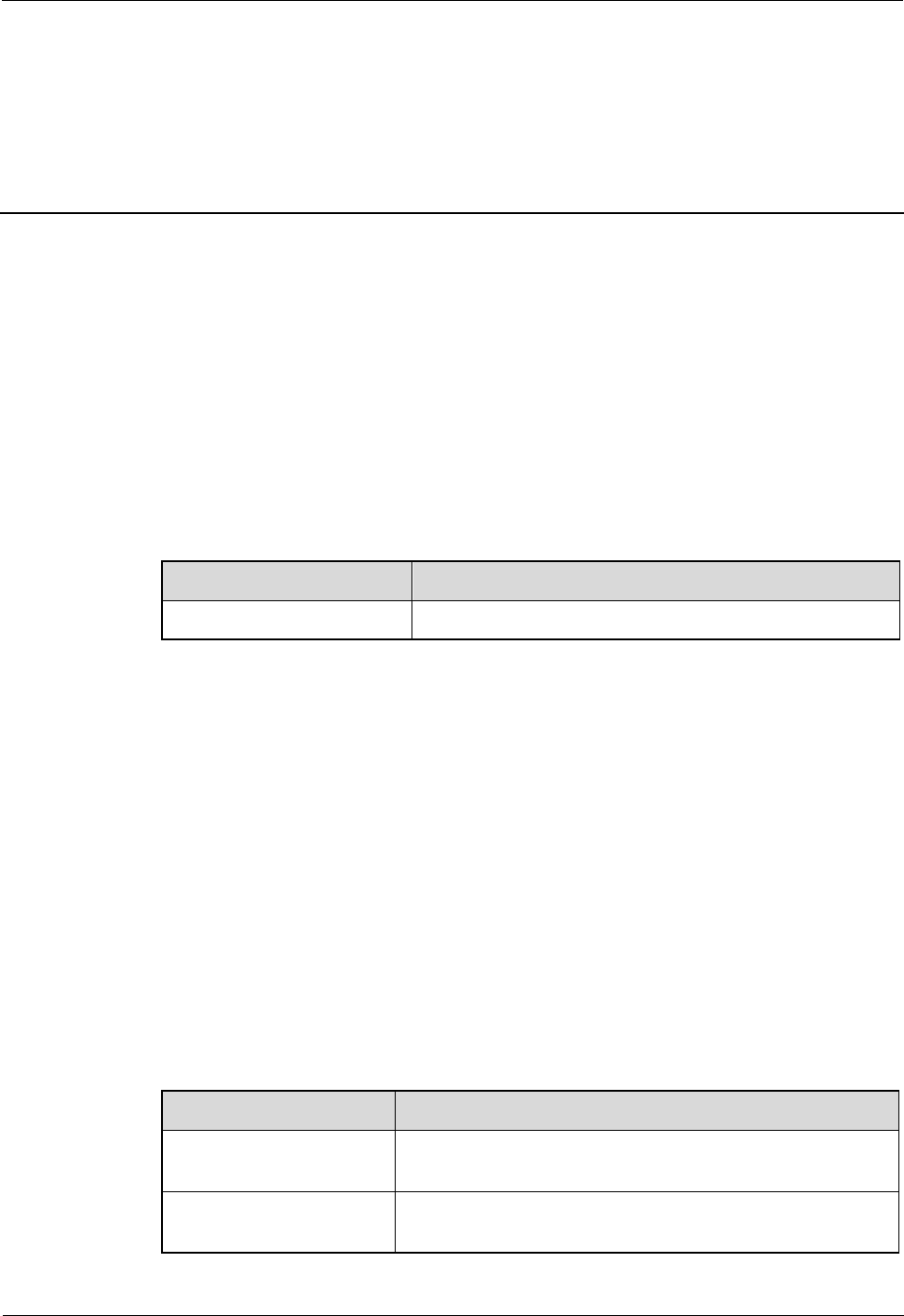
BTS3202E
Compliance and Safety Manual
About This Document
Issue 02 (2012-04-30)
Huawei Proprietary and Confidential
Copyright © Huawei Technologies Co., Ltd
vii
About This Document
Purpose
This document describes the compliance of the BTS3202E with Electromagnetic
Compatibility (EMC) and other safety standards, and provides general safety guidelines for
handling, installing or operating the BTS3202E.
Related Versions
The following table lists the product versions related to this document.
Product Name
Version
BTS3202E
V100R005C00
Intended Audience
The intended audience of this document are:
Technical support engineers
Installation engineers
maintenance engineers
Network planning engineers
Organization
This document consists of the following chapters.
Chapter
Description
1 Regulatory Compliance
Statement
This chapter provides the European community CE
certification DoC of the BTS3202E.
2 Regulatory Compliance
Information
This chapter describes the standards compliance of the
BTS3202E.
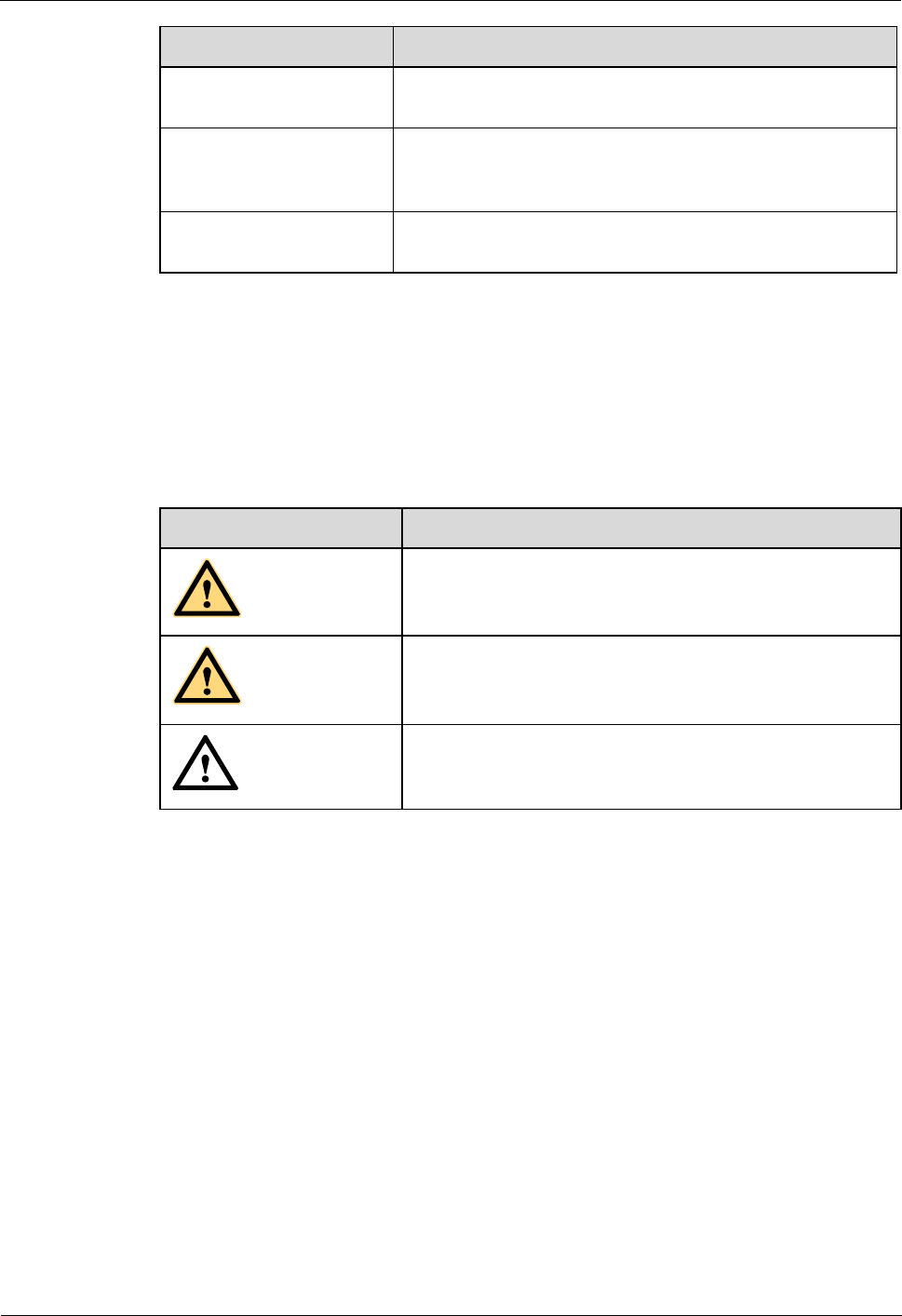
BTS3202E
Compliance and Safety Manual
About This Document
Issue 02 (2012-04-30)
Huawei Proprietary and Confidential
Copyright © Huawei Technologies Co., Ltd
viii
Chapter
Description
3 Safety Information
This chapter covers the general guidelines for handling,
installing or operating the BTS3202E.
4 Sicherheitsinformationen
Dieses Kapitel beinhandelt die allgemeinen Richtlinien
betreffend der Behandlung, Installation und Benutzung des
BTS3202E.
Appendix A Acronyms
and Abbreviations
This appendix lists the acronyms and abbreviations used in
this manual.
Conventions
Symbol Conventions
The following symbols may be found in this document. They are defined as follows.
Symbol
Description
DANGER
Indicates a hazard with a high level of risk which, if not
avoided, will result in death or serious injury.
WARNING
Indicates a hazard with a low or medium level of risk which,
if not avoided, could result in minor or moderate injury.
CAUTION
Indicates a potentially hazardous situation that, if not
avoided, could cause equipment damage, data loss, and
performance degradation, or unexpected results.

BTS3202E
Compliance and Safety Manual
1 Regulatory Compliance Statement
Issue 02 (2012-04-30)
Huawei Proprietary and Confidential
Copyright © Huawei Technologies Co., Ltd
1-1
1 Regulatory Compliance Statement
1.1 About This Chapter
This chapter provides the certification details for BTS3202E:
European Community CE Certification Declaration of Conformity (DoC)
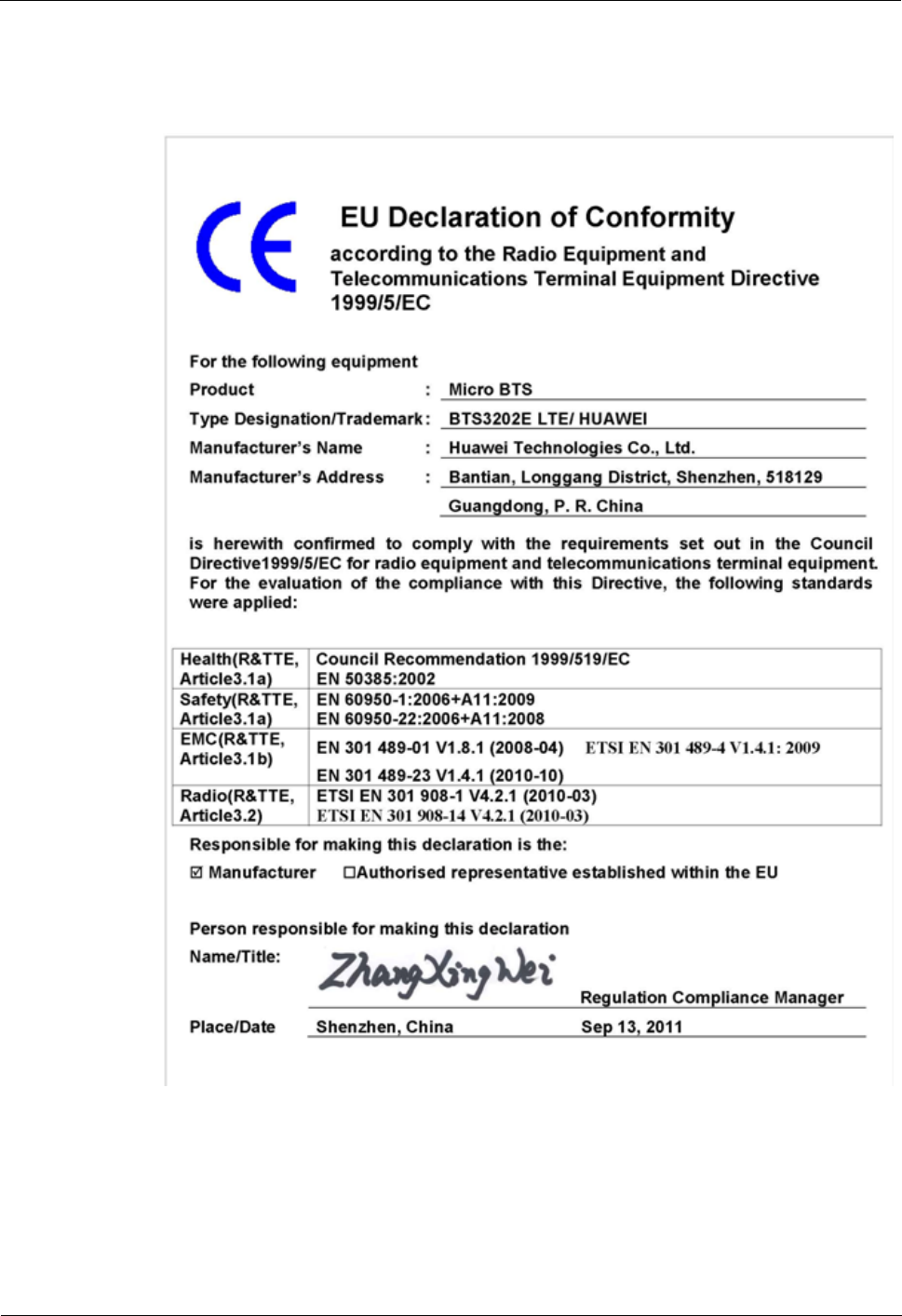
BTS3202E
Compliance and Safety Manual
1 Regulatory Compliance Statement
Issue 02 (2012-04-30)
Huawei Proprietary and Confidential
Copyright © Huawei Technologies Co., Ltd
1-2
1.2 European Community CE Certification DoC
Figure 1-1 European community CE certification DoC
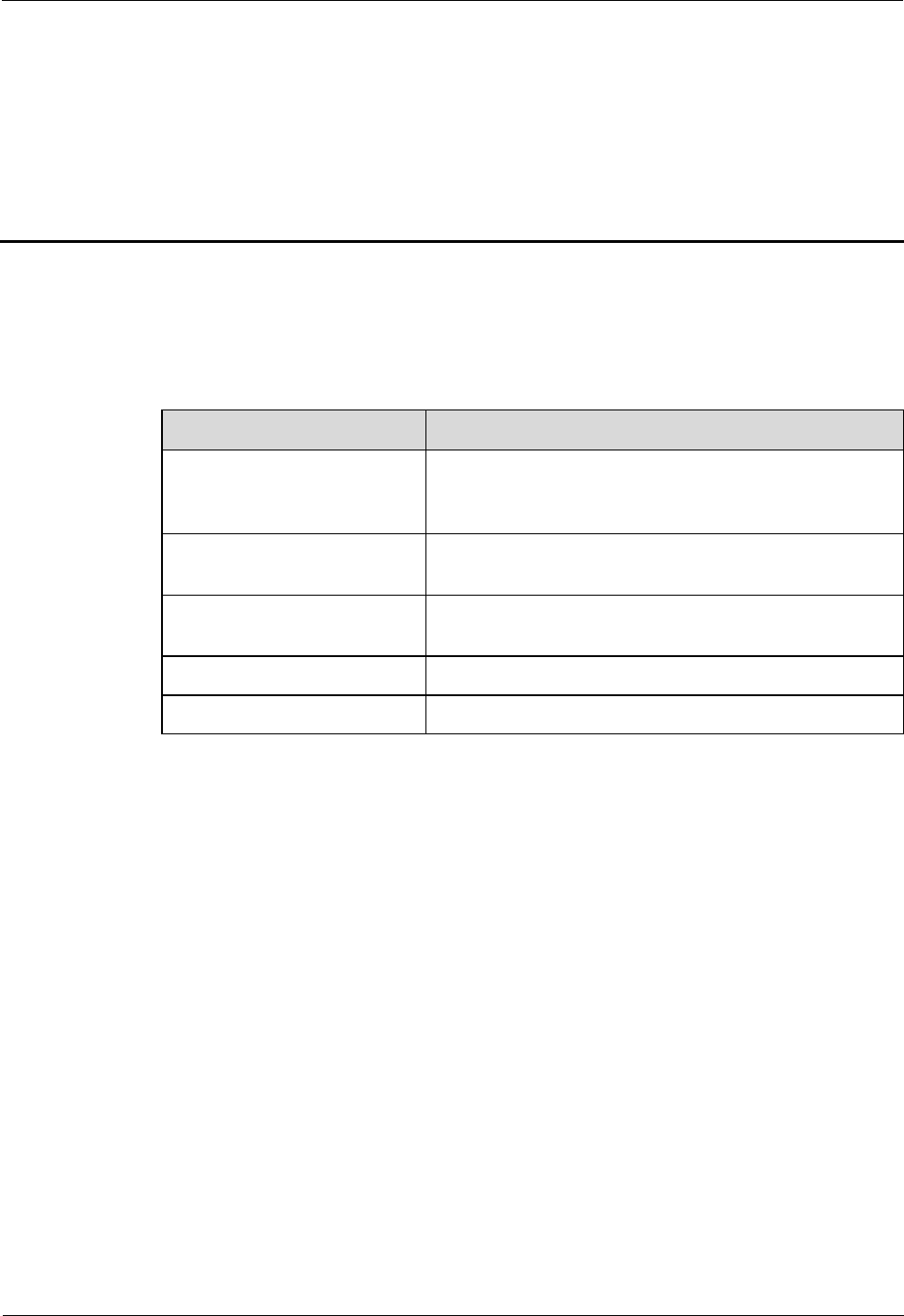
BTS3202E
Compliance and Safety Manual
2 Regulatory Compliance Information
Issue 02 (2012-04-30)
Huawei Proprietary and Confidential
Copyright © Huawei Technologies Co., Ltd
2-1
2 Regulatory Compliance Information
2.1 About This Chapter
The following table lists the contents of this chapter.
Title
Description
2.2 Regulatory Compliance
Standards
The regulatory compliance standards on EMC, safety,
NEBS, telecom, Laser Radiation, RF, health, and
environmental protection.
2.3 European Directives
Compliance
The compliance with European directives, including
RoHS compliance and device recycling guide.
2.4 USA Regulatory
Compliance
The USA regulatory compliance, including FCC part 15.
2.5 Japanese Compliance
The Japan regulatory compliance.
2.6 CISPR 22 Compliance
The CISPR 22 regulatory compliance.
2.2 Regulatory Compliance Standards
BTS3202E complies with the standards listed in Table 2-1.

BTS3202E
Compliance and Safety Manual
2 Regulatory Compliance Information
Issue 02 (2012-04-30)
Huawei Proprietary and Confidential
Copyright © Huawei Technologies Co., Ltd
2-2
Table 2-1 Regulatory compliance standards
Discipline
Standards
EMC
CISPR22 Class B
CISPR24
EN55022 Class B
EN50024
ETSI EN 301 489 Class B
CFR 47 FCC Part 15 Class B
FCC Part 2
FCC Part 22
FCC Part 24
ICES 003 Class B
AS/NZS CISPR22 Class B
GB9254 Class B
VCCI Class B
CNS 13438 Class B
IEC61000-3-2
IEC61000-3-3
EN61000-3-2
EN61000-3-3
ITU-T K.20
ITU-T K.44
ITU-T K.45
Safety
IEC 60950-1
IEC60950-21
IEC60950-22
IEC60065
IEC/EN60215
IEC/EN41003
EN 60950-1
UL 60950-1
CSA C22.2 No 60950-1
AS/NZS 60950.1
BS EN 60950-1
IS 13252
GB4943
GB8898
Laser safety
FDA rules, 21 CFR 1040.10 and 1040.11
IEC60825-1, IEC60825-2, EN60825-1, EN60825-2
GB7247

BTS3202E
Compliance and Safety Manual
2 Regulatory Compliance Information
Issue 02 (2012-04-30)
Huawei Proprietary and Confidential
Copyright © Huawei Technologies Co., Ltd
2-3
Discipline
Standards
RF
ETSI EN 301 908-1 (2011-05)
ETSI EN 301 908-14 (2011-05)
47 CFR FCC Part 27, Subpart C (10-1-10 Edition)
IC RSS-Gen (Issue 3, December 2010)
IC RSS-139 (Issue 2, February 2009)
IC RSS-199 (Issue 1, January 2010)
Health
ICNIRP Guideline
1999-519-EC
EN 50385
OET Bulletin 65
IEEE Std C95.1
EN 60215
Environmental protection
RoHS
Grounding
ITU-T K.27
ETSI EN 300 253

BTS3202E
Compliance and Safety Manual
2 Regulatory Compliance Information
Issue 02 (2012-04-30)
Huawei Proprietary and Confidential
Copyright © Huawei Technologies Co., Ltd
2-4
Discipline
Standards
Note:
EMC: electromagnetic compatibility
NEBS: Network Equipment Build Standard
RF: radio frequency
CISPR: International Special Committee on Radio Interference
EN: European Standard
ETSI: European Telecommunications Standards Institute
CFR: Code of Federal Regulations
FCC: Federal Communication Commission
IEC: International Electrotechnical Commission
AS/NZS: Australian/New Zealand Standard
VCCI: Voluntary Control Council for Interference
CNS: Chinese National Standard
UL: Underwriters Laboratories
CSA: Canadian Standards Association
BS: British Standard
IS: Indian Standard
GR: general requirement
FDA: Food and Drug Administration
BTS: base transceiver station
GSM: Global System for Mobile communications
WLAN: wireless local area network
ICNIRP: International Commission on Non-Ionizing Radiation Protection
OET: Office of Engineering Technology
IEEE: Institute of Electrical and Electronics Engineers
RoHS: restriction of the use of certain hazardous substances
2.3 European Directives Compliance
BTS3202E complies with the following European directives.
2004/108/EC (EMC)
2006/95/EC (low voltage)
1999/5/EC (R&TTE)
Refer to Figure 1-1 for Huawei Declaration of Conformity.
BTS3202E complies with Directive 2002/95/EC, on the RoHS in electrical and electronic
equipment. The device does not contain lead, mercury, cadmium, and hexavalent chromium
and brominated flame retardants (polybrominated biphenyls (PBB) or polybrominated

BTS3202E
Compliance and Safety Manual
2 Regulatory Compliance Information
Issue 02 (2012-04-30)
Huawei Proprietary and Confidential
Copyright © Huawei Technologies Co., Ltd
2-5
diphenyl ethers (PBDE)) except for those exempted applications allowed by RoHS directive
for technical reasons.
BTS3202E complies with Directive 2002/96/EC on waste electrical and electronic equipment.
Huawei is responsible for recycling its end-of-life devices. Contact Huawei local service
center when recycling is required.
The main materials in the device are steel, plastics, copper, and electronic components. Most
of the materials are recyclable.
Table 2-2 lists the main materials used in the device.
Table 2-2 Main materials used in the device
Part
Material
Weight (kg)
Percentage (Based on
Device Weight)
Substance
Prohibited
by RoHS
Cabinet
Fe
100
24.2%
No
Al
20
4.8%
No
Cu
5
1.2%
Pb (<0.4%)
ABS
8
1.9%
Deca-BDE
……
-
……
Shelf
Fe
20
24.2%
No
Al
5
4.8%
No
Cu
2
1.2%
No
ABS
3
1.9%
Deca-BDE
……
-
……
Cable
Typical
configuration
(20-meter E1
cable x 32)
250
60.5%
No
Other
configuration
(Weight for each
meter)
5
-
No
PCBs
Typical
configuration (12
PCBs,
components
included)
30
7.3%
Pb (in
solder)
Other
configuration
(Weight of each
PCB)
2
-
No

BTS3202E
Compliance and Safety Manual
2 Regulatory Compliance Information
Issue 02 (2012-04-30)
Huawei Proprietary and Confidential
Copyright © Huawei Technologies Co., Ltd
2-6
Total
Typical
configuration
413
100%
-
Comply with the following rules for recycling at the end of life of the device.
Remove xx first in the disassembly.
Remove and send xx to special institution for disposal because it contains chemical
substance.
Dispose of xx separately because it contains hazardous substance.
No hazardous substance is contained in the label printing ink and plastic paint, and no
hazardous gas is emitted when the label printing ink and plastic paint is burning.
Dispose of the yellow chromate conversion coating screw separately because it contains
Cr6+.
Provide the plastic marking reference, such as ISO1043, and EN50419.
2.4 USA Regulatory Compliance
2.4.1 FCC Part 15
BTS3202E complies with Part 15 of the FCC Rules. Operation is subject to the following two
conditions:
This device does not cause harmful interference.
This device must accept any interference received, including interference that may cause
undesired operation.
If this device is modified without authorization from Huawei, the device may no longer
comply with FCC requirements for Class B digital devices. In that a case, your right to use the
device may be limited by FCC regulations. Moreover, you may be required to correct any
interference to radio or television communications at your own expense.
This device has been tested and found to comply with the limits for a Class B digital device,
pursuant to Part 15 of the FCC rules. These limits are designed to provide reasonable
protection against harmful interference in a residential installation.
This device generates, uses and radiates radio frequency energy. If it is not installed and used
in accordance with the instructions, it may cause harmful interference to radio
communications.
However, there is no guarantee that interference will not occur in a particular installation. If
this device does cause harmful interference to radio or television reception, which can be
determined by turning the device off and on, the user may take one or more of the following
measures:
Reorient or relocate the receiving antenna.
Reinforce the separation between the device and receiver.
Connect the device into an outlet on a circuit different from that to which the receiver is
connected.
Consult the dealer or an experienced radio or TV technician for assistance.
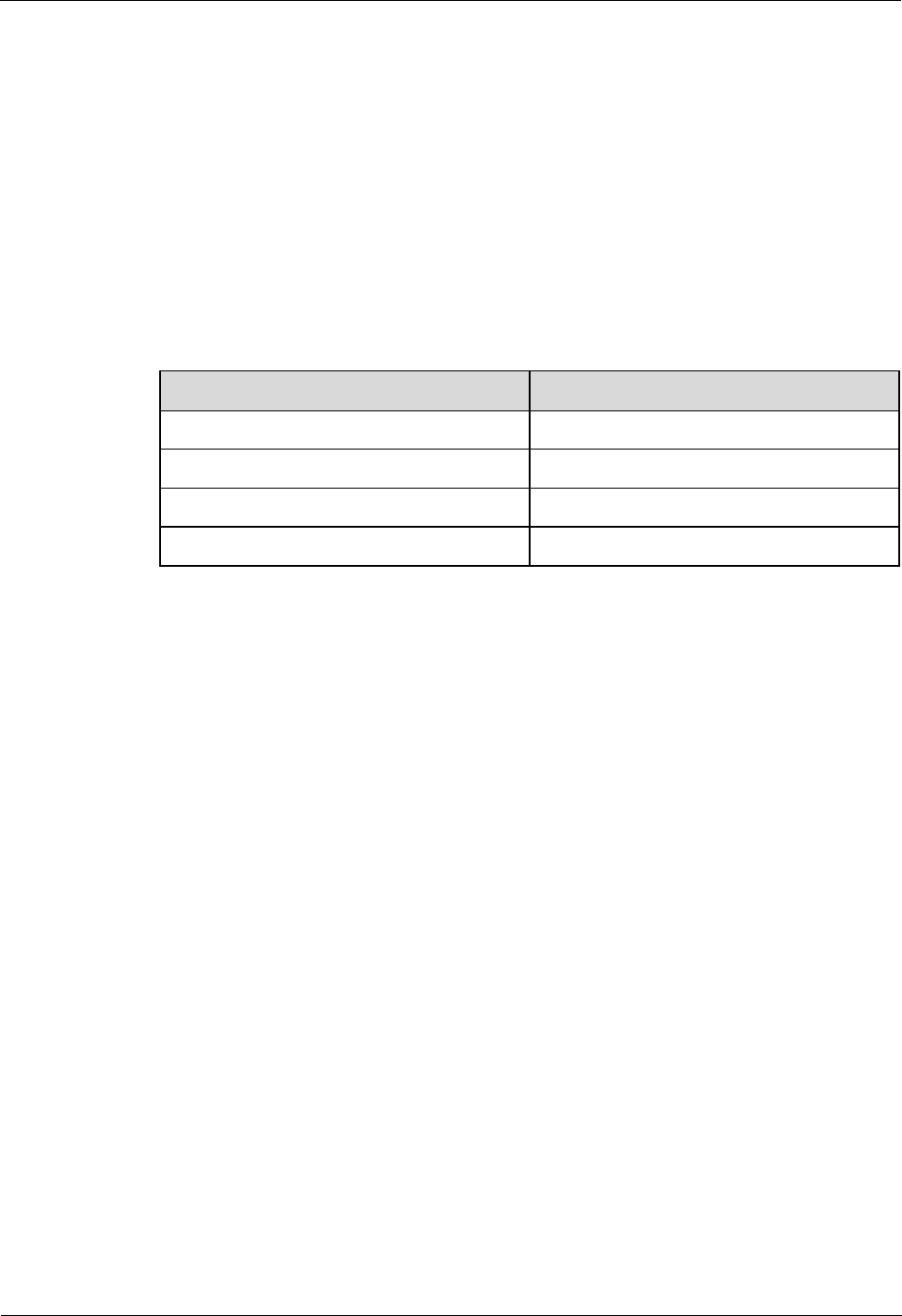
BTS3202E
Compliance and Safety Manual
2 Regulatory Compliance Information
Issue 02 (2012-04-30)
Huawei Proprietary and Confidential
Copyright © Huawei Technologies Co., Ltd
2-7
2.5 Japanese Compliance
2.5.1 VCCI
BTS3202E complies with VCCI Class B by Information Technology Equipment (ITE).
2.5.2 JATE
BTS3202E meets the requirements of the Japan Approvals Institute for Telecommunications
Equipment (JATE).
Table 2-3 lists the JATE approval numbers for modules.
Table 2-3 JATE approval number for modules
Module Number
Approval Number
2.6 CISPR 22 Compliance
BTS3202E complies with CISPR 22 for Class B by the ITE.
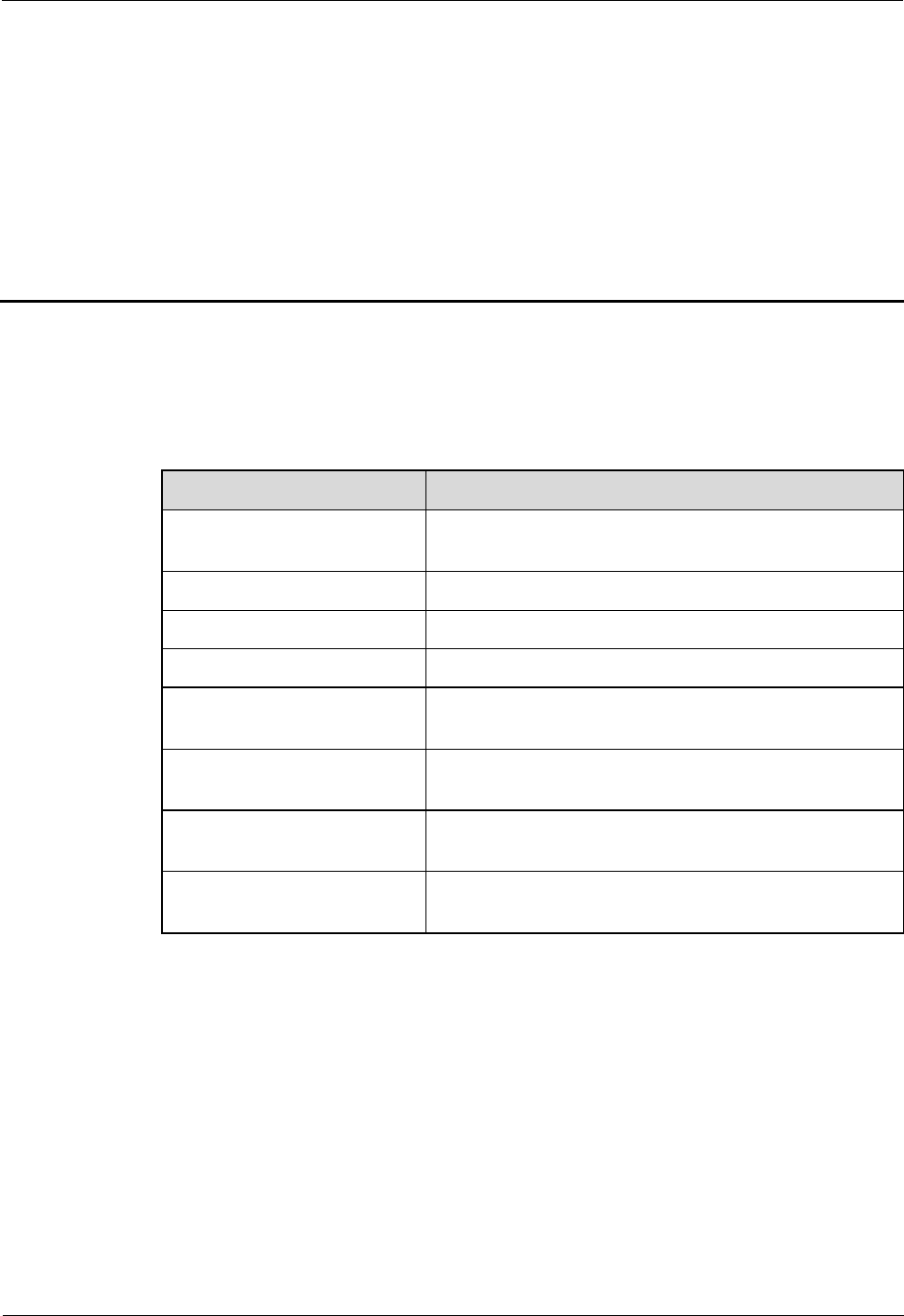
BTS3202E
Compliance and Safety Manual
3 Safety Information
Issue 02 (2012-04-30)
Huawei Proprietary and Confidential
Copyright © Huawei Technologies Co., Ltd
3-1
3 Safety Information
3.1 About This Chapter
The following table lists the contents of this chapter.
Title
Description
3.2 Overview
Safety precautions to be taken before installing and
maintaining the Huawei device.
3.3 Electricity Safety
Information about the electricity safety.
3.4 Inflammable Environment
Information about the inflammable environment safety.
3.5 Battery
Information about the battery safety.
3.6 Radiation
Safety precautions on the Electromagnetic Field Exposure
of the device and laser.
3.7 Working at Heights
Safety precautions to be taken before using the ladders or
hoisting heavy objects.
3.8 Mechanical Safety
Safety precautions on drilling, on sharp objects, on
handling fans, and on lifting heavy objects.
3.9 Miscellaneous
Safety precautions on inserting and removing boards, on
bundling signal cables, and cabling requirements.
3.2 Overview
3.2.1 Safety Precautions
This section describes the safety precautions to be taken before installing and maintaining the
Huawei device.
Before performing an operation, read the operation instructions and precautions to be
taken, and follow them to prevent accidents. The Caution, Warning and Danger items in
other documents do not cover all the safety precautions that must be followed. They are

BTS3202E
Compliance and Safety Manual
3 Safety Information
Issue 02 (2012-04-30)
Huawei Proprietary and Confidential
Copyright © Huawei Technologies Co., Ltd
3-2
only supplementary information. The installation and maintenance personnel need to
understand the basic safety precautions to be taken.
When operating the device, obey the local safety regulations. The safety precautions
provided in the documents are supplementary and shall be in compliance with the local
safety regulations.
When operating the Huawei device, in addition to the precautions, follow the specific
safety instructions given by Huawei.
The installation and maintenance personnel must receive training in safety precautions.
Only qualified personnel can install or maintain the device.
3.2.2 General Requirements
To minimize the technically residual risk, it is imperative to obey the following rules. Read all
the instructions before operation.
Installation
The device (or system) must be installed or used in the access restricted location.
Before operation, the device must be fixed securely on the floor or to other reliable
objects, such as the walls and the mounting racks.
When installing the unit, always make the ground connection first and disconnect it at
the end.
Ground
Do not damage the ground conductor or operate the device in the absence of well
installed ground conductor. Conduct the appropriate electrical inspection.
The device (or system) must be connected permanently to the protection ground before
an operation. The cross sectional area of protective ground conductor shall be at least
0.75 mm².
Power Supply
For AC supplied model: The device applies to TN or TT power systems.
Prepared conductors are connected to the terminal block, and only appropriate
AWG/Type of wire is secured in the listed lug terminals.
This device relies on the building’s installation for short-circuit (overcurrent) protection.
Ensure that a fuse or circuit breaker no larger than 120 VAC, 20 A U.S. (240 VAC, 20 A
international) for AC supplied model supplied model is used on the phase conductors (all
current-carrying conductors).
For this device, a readily accessible disconnect device shall be incorporated in the
building installation wiring.
The AC power supply has double pole/neutral fusing.
To reduce the risk of fire, use only No. 26 AWG or larger telecommunication line cord.
Human Safety
Do not operate the device or cables at lightning strikes.
To avoid electric shock, do not connect safety extra-low voltage (SELV) circuits to
telecommunication network voltage (TNV) circuits.
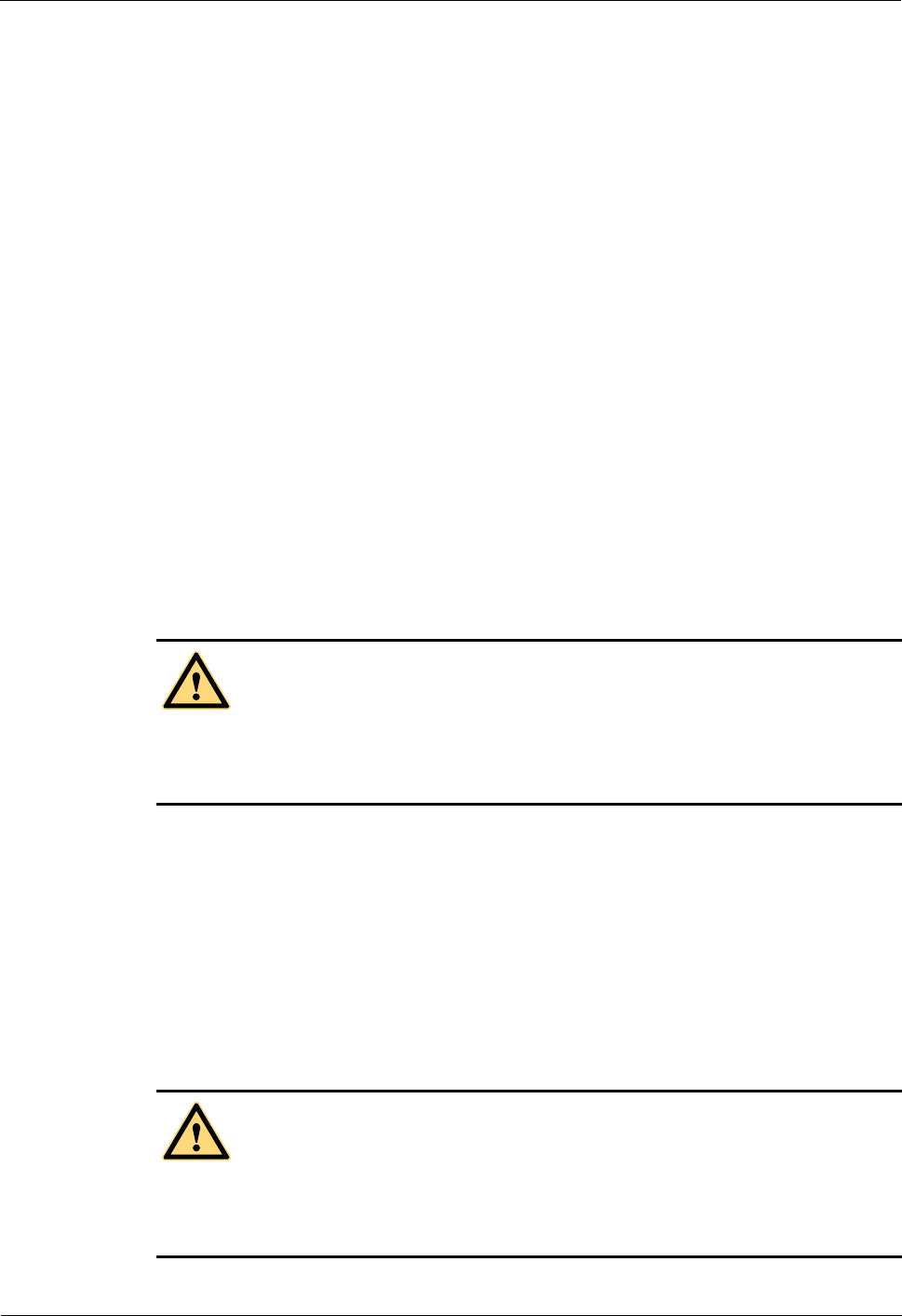
BTS3202E
Compliance and Safety Manual
3 Safety Information
Issue 02 (2012-04-30)
Huawei Proprietary and Confidential
Copyright © Huawei Technologies Co., Ltd
3-3
Do not look directly into the optical port to prevent the laser radiation from injuring your
eyes.
Do not wear jewelry or watches when you operate the device.
Operator
Only qualified and skilled personnel must install, configure, and disassemble the device.
Only the personnel authorized must operate the device.
Any replacement or change to the device or parts of the device (including the software)
must be done by qualified or authorized personnel of Huawei.
Any fault or error that might cause safety problems must be reported immediately to the
person in charge.
Only qualified personnel must remove or disable the safety facilities, or to troubleshoot
and maintain the device.
Ensure that the instructions provided in this document are followed completely. The document
also provides guidelines in selecting the measuring and testing device.
3.3 Electricity Safety
3.3.1 High Voltage
DANGER
The high voltage power supply offers power for the device operation. Direct or indirect
contact (through damp objects) with high voltage and AC mains supply may result in fatal
danger.
During the installation of the AC power supply facility, follow the local safety
regulations. The personnel who install the AC facility must be qualified to perform high
voltage and AC operations.
Do not wear conductive articles, such as watches, hand chains, bracelets and rings during
the operation.
When water is found in the rack or the rack is damp, switch off the power supply
immediately.
When the operation is performed in a damp environment, make sure that the device is
dry.
WARNING
Non-standard and improper high voltage operations may result in fire and electric shock.
Therefore, you must obey the local rules and regulations when bridging and wiring AC cables.
Only qualified personnel must perform high voltage and AC operations.
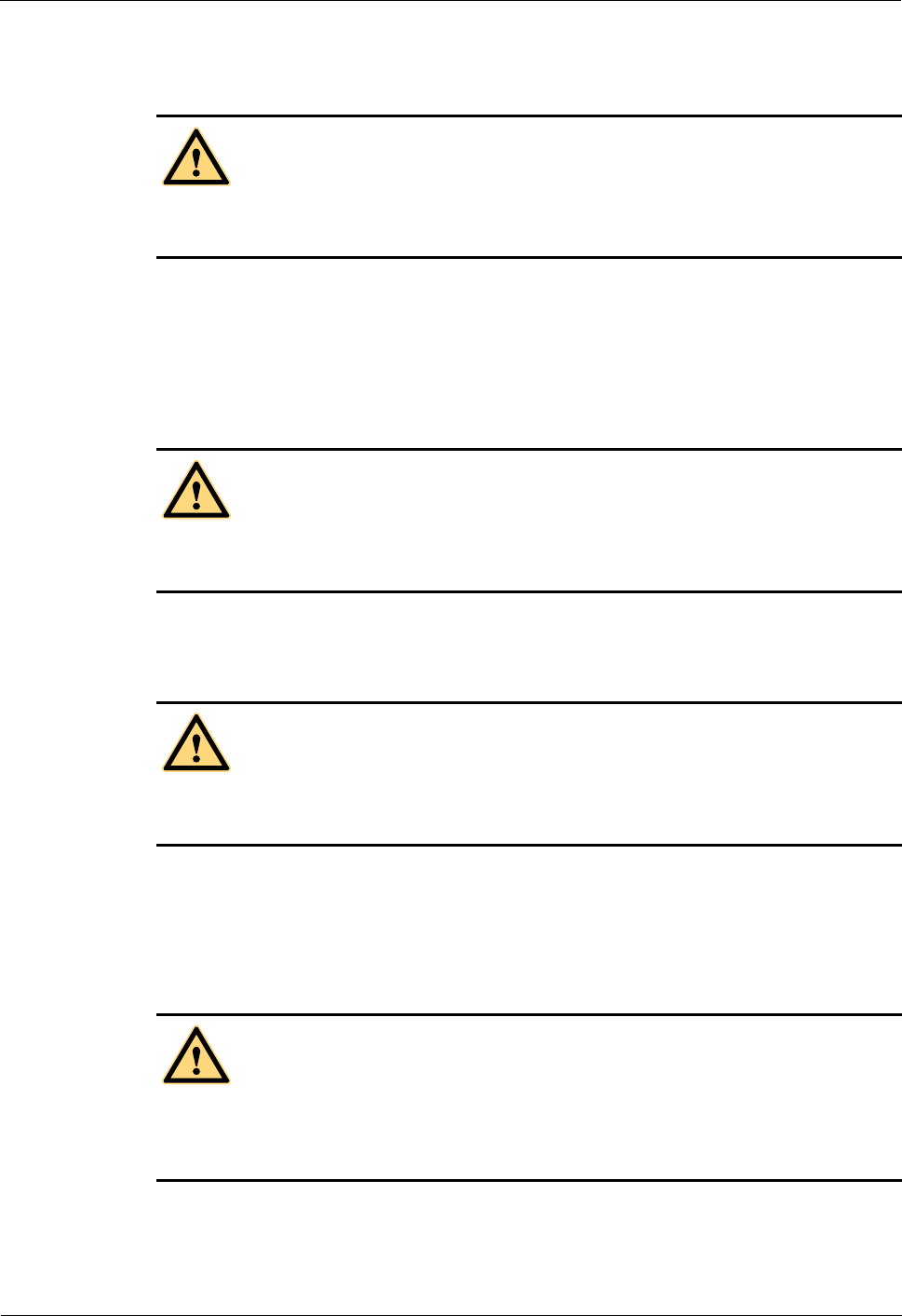
BTS3202E
Compliance and Safety Manual
3 Safety Information
Issue 02 (2012-04-30)
Huawei Proprietary and Confidential
Copyright © Huawei Technologies Co., Ltd
3-4
3.3.2 Thunderstorm
DANGER
High voltage and AC operations, or operations on a steel tower and a mast are prohibited
during thunderstorm.
During thunderstorm, the electromagnetic field generated in the thunderstorm area may
damage the electronic parts. To prevent damage to the device during lightning, ground the
device properly.
3.3.3 Tools
WARNING
Suggestion: Dedicated tools must be used during high voltage and AC operations. Avoid using
ordinary tools.
3.3.4 High Electrical Leakage
WARNING
Ground the device before powering on the device. Otherwise, the personnel and device are
in danger.
If the "high electrical leakage" flag is stuck to the power terminal of the device, you must
ground the device before powering it on.
3.3.5 Power Cable
WARNING
Installation and removal of live line are prohibited. Transient contact between the core of the
power cable and the conductor may generate electric arc or spark, which may cause fire or eye
injury.
Before installing or removing the power cable, turn off the power switch.
Before connecting the power cable, confirm that the power cable and label comply with
the requirements of the actual installation.
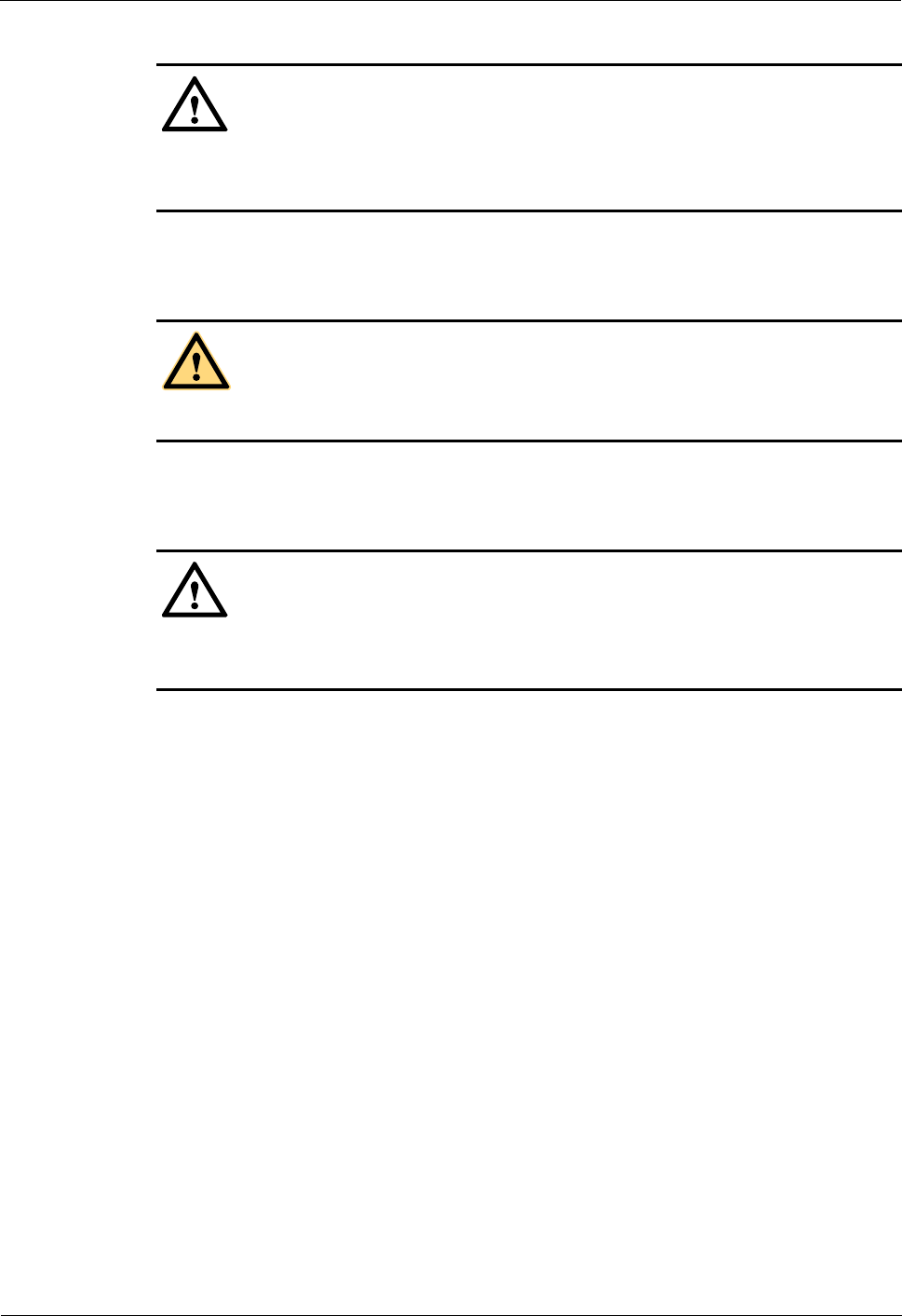
BTS3202E
Compliance and Safety Manual
3 Safety Information
Issue 02 (2012-04-30)
Huawei Proprietary and Confidential
Copyright © Huawei Technologies Co., Ltd
3-5
CAUTION
For AC power supplied device, use 0.75 mm² or 18 AWG minimum power supply cord.
Use the type H03VV-F or light PVC sheathed flexible cord based on IEC 60227.
3.3.6 Fuse
WARNING
If a fuse is to be replaced, the new fuse shall be of the same type and specifications.
3.3.7 Electrostatic Discharge
CAUTION
The static electricity generated by the human body may damage the electrostatic sensitive
components on the circuit board, such as the large-scale integrated circuit (LSI).
In the following situations, the human body will generate a static electromagnetic field:
Human body moving
Clothes friction
Friction between shoes and the ground
Holding ordinary plastic in hand
The static electromagnetic field will remain within the human body for a long time.
Before touching the device, hand-operating parts, circuit boards, or ASICs, wear a grounded
electrostatic discharge (ESD) wrist strap. It can prevent the sensitive components from
damage by the static electricity in the human body.
Figure 3-1 shows the wearing of an ESD wrist strap.
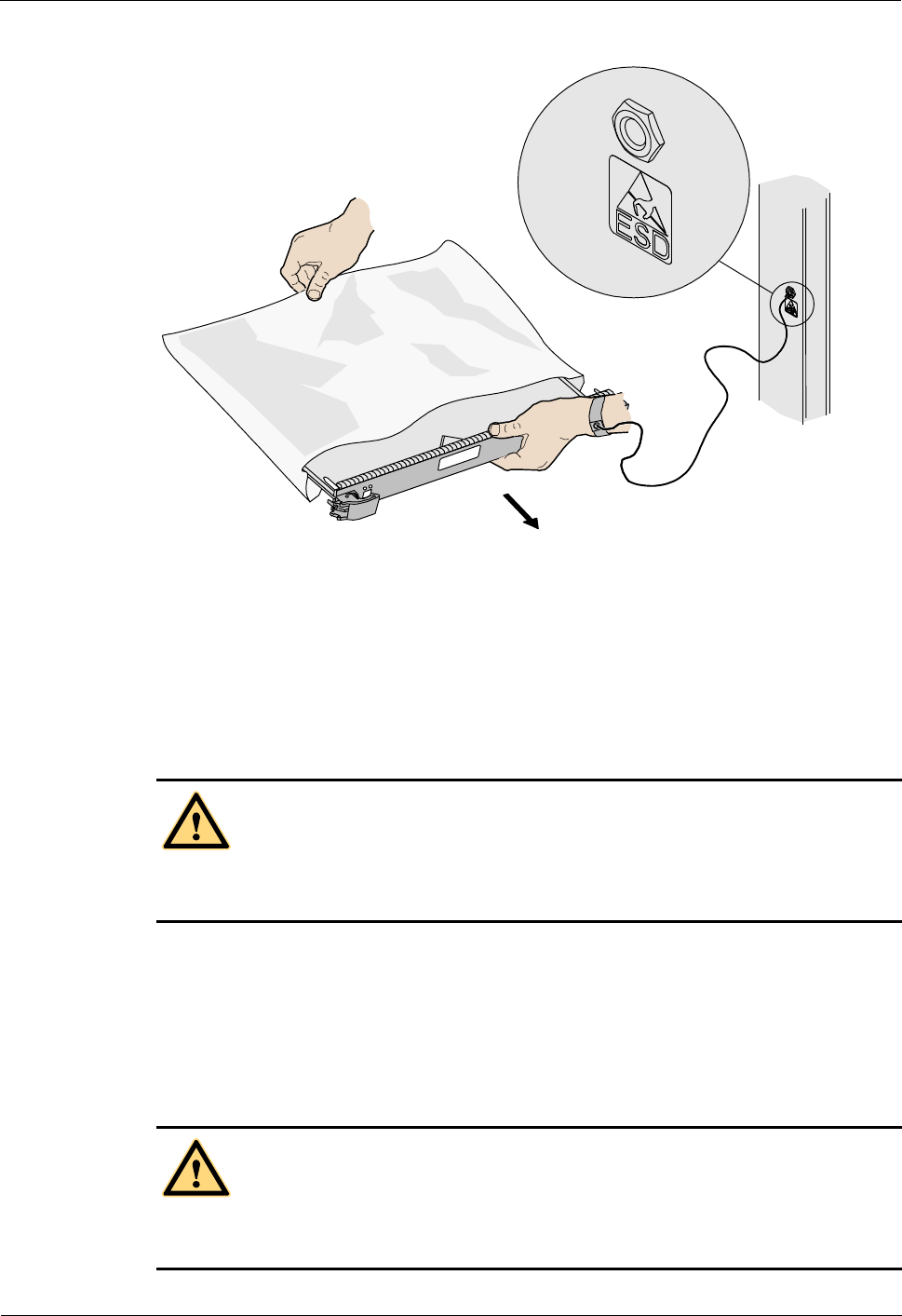
BTS3202E
Compliance and Safety Manual
3 Safety Information
Issue 02 (2012-04-30)
Huawei Proprietary and Confidential
Copyright © Huawei Technologies Co., Ltd
3-6
Figure 3-1 Wearing an ESD wrist strap
3.4 Inflammable Environment
Operating the electrical device in inflammable environment can be fatal.
DANGER
Do not place the device in the environment that has inflammable and explosive air or fog. Do
not perform any operation in this environment.
3.5 Battery
3.5.1 Storage Battery
DANGER
Before handling the battery, read carefully the safety precautions to be taken for battery
handling and connections.
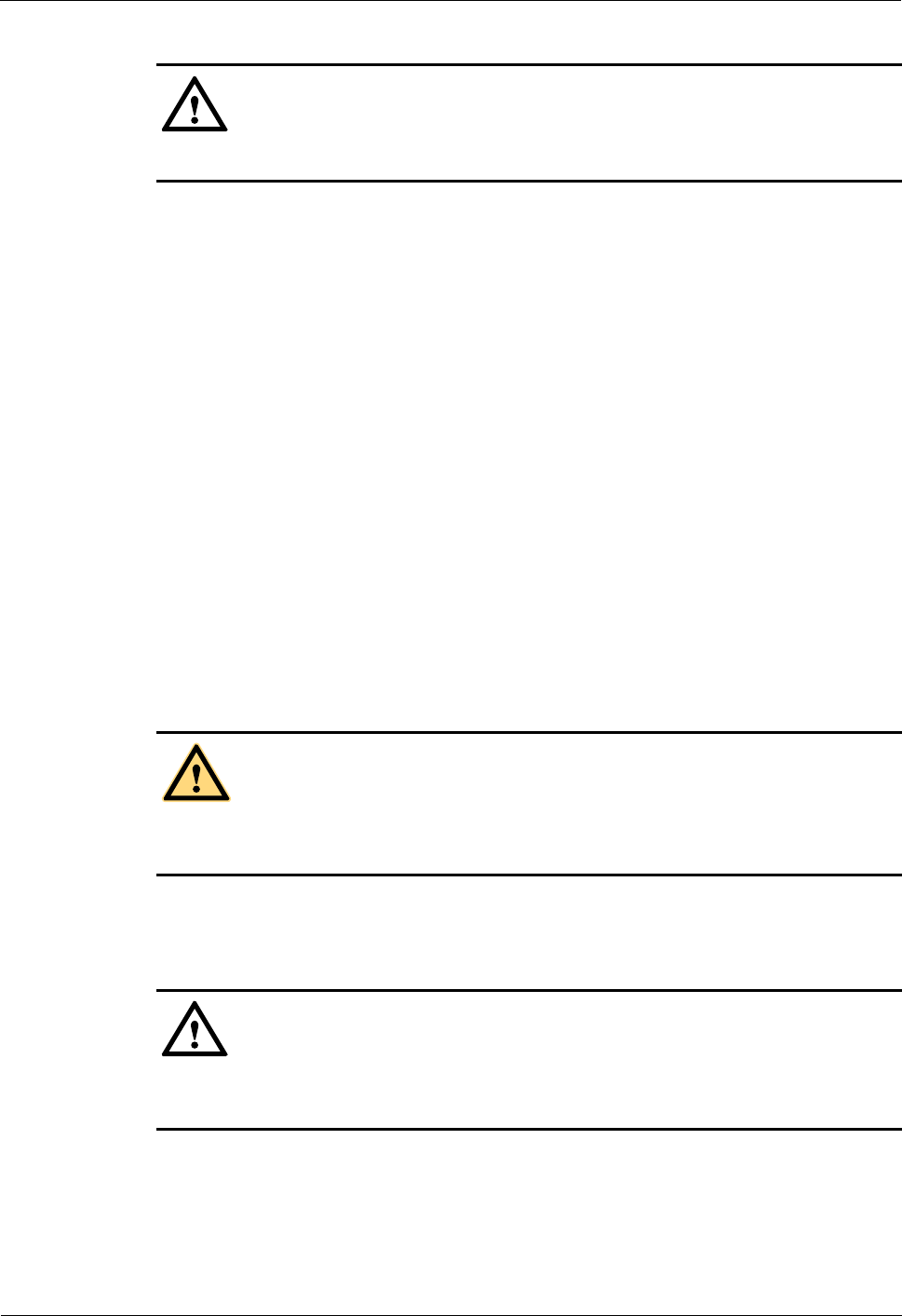
BTS3202E
Compliance and Safety Manual
3 Safety Information
Issue 02 (2012-04-30)
Huawei Proprietary and Confidential
Copyright © Huawei Technologies Co., Ltd
3-7
CAUTION
Non-standard operation on batteries may result in danger.
During operation:
Protect the battery against short-circuit
Prevent electrolyte overflow and leakage
Electrolyte overflow may damage the device. It will corrode the metal parts and the circuit
boards, and ultimately damage the device and cause short-circuit of the circuit boards.
General Operations
Before installing and maintaining the battery, note the following:
Do not wear metal articles such as wristwatch, hand chain, bracelet and ring.
Use special-purpose insulation tools.
Take care to protect you eyes when operating the device.
Wear rubber gloves and an apron in the case of electrolyte overflow.
Always keep the electrode front upright when handling the battery. Do not place the
battery upside down or tilt it.
Short-Circuit
WARNING
Battery short-circuit may cause physical injury. Though voltage of a general battery is low,
high transient current generated by short-circuit will release a large amount of power.
There is danger of explosion if the battery is incorrectly replaced. Therefore, replace the
battery only with the same or equivalent type recommended by the manufacturer.
CAUTION
Keep away metal objects, which may cause battery short-circuit, from batteries. If they have
to be used, first disconnect the batteries in use before performing any other operations.
Harmful Gas
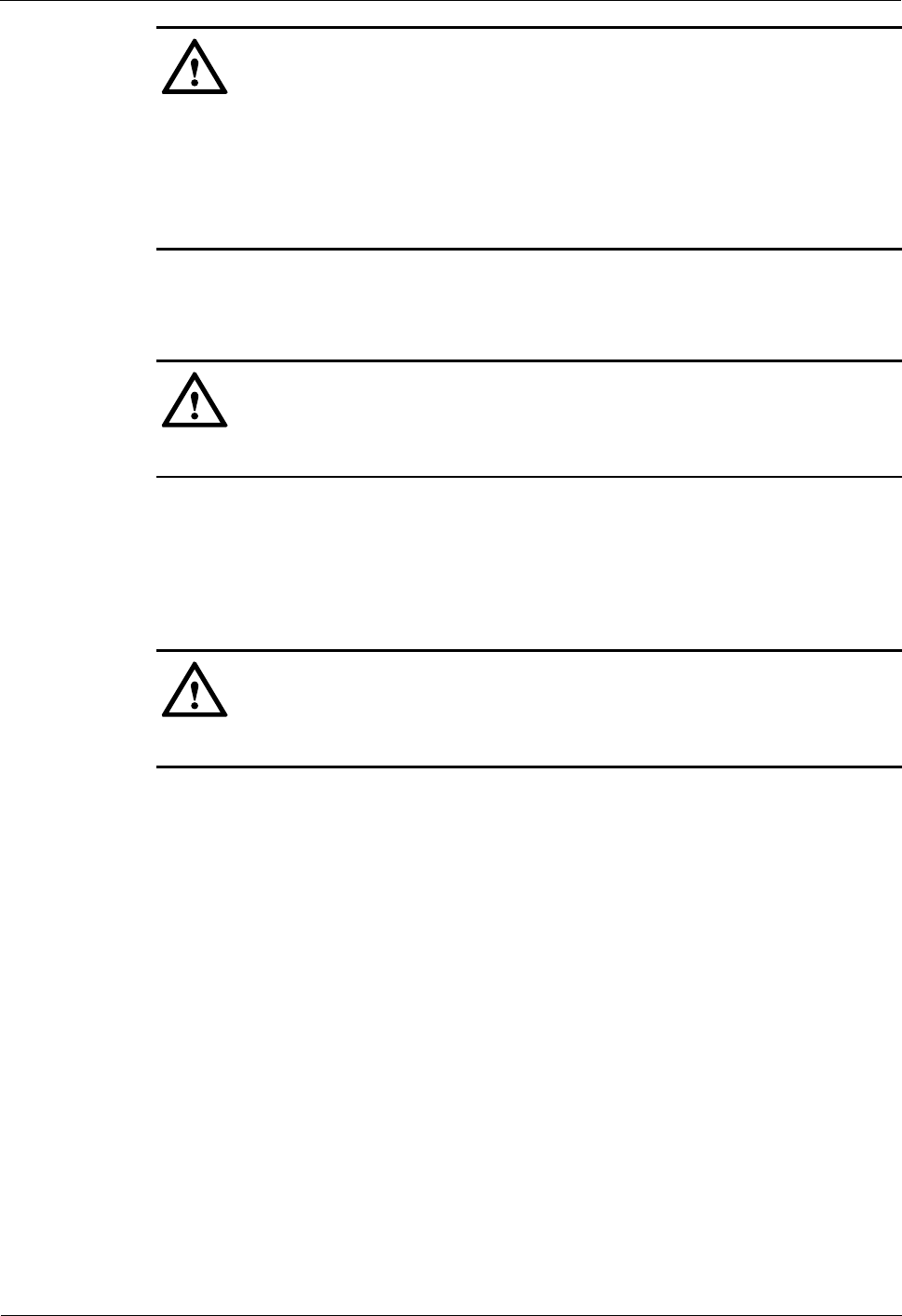
BTS3202E
Compliance and Safety Manual
3 Safety Information
Issue 02 (2012-04-30)
Huawei Proprietary and Confidential
Copyright © Huawei Technologies Co., Ltd
3-8
CAUTION
Do not use unsealed lead-acid batteries, because the gas emitted from the battery may
result in fire or device corrosion.
Lay the battery horizontally and fix it properly.
The battery in use will emit flammable gas. Therefore, put the battery in a place with good
ventilation, and take fire precautions.
High Temperature
CAUTION
High temperature may result in distortion, damage and electrolyte overflow of the battery.
When the temperature of the battery exceeds 60C, check whether there is acid liquid
overflow. If acid liquid overflow occurs, handle the acid liquid immediately.
Acid Liquid
CAUTION
In case of acid liquid overflow, absorb and neutralize the liquid immediately.
When moving or removing a leaky battery, note the possible damage caused by the acid liquid.
Once the acid liquid spill is found, use the following materials to absorb and neutralize it.
Sodium bicarbonate (baking soda): NaHCO3
Sodium carbonate (soda): Na2CO3
The use of antacids must follow the guide provided by the battery supplier.
3.6 Radiation
3.6.1 Electromagnetic Field Exposure
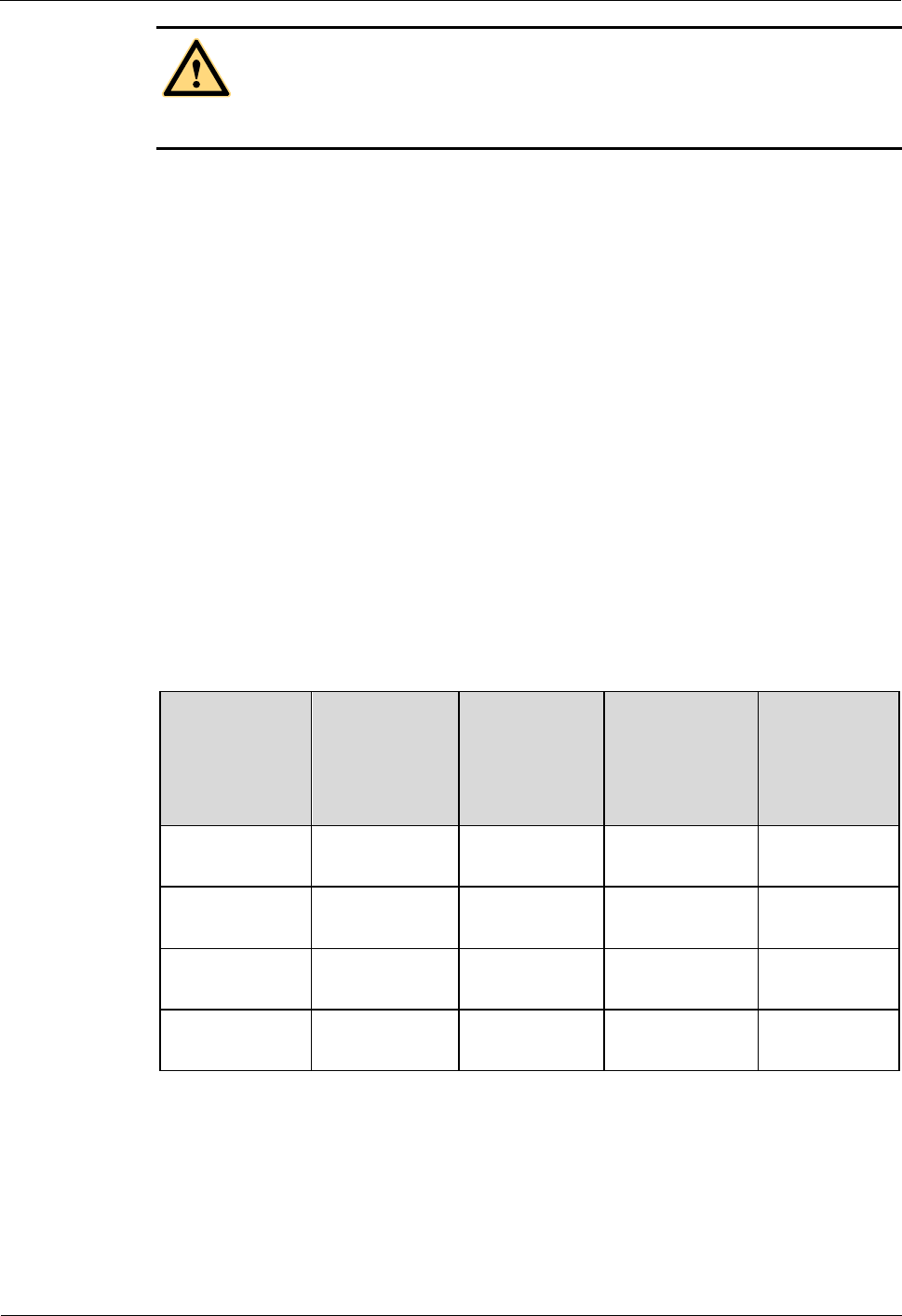
BTS3202E
Compliance and Safety Manual
3 Safety Information
Issue 02 (2012-04-30)
Huawei Proprietary and Confidential
Copyright © Huawei Technologies Co., Ltd
3-9
WARNING
Radio-frequency signals with high intensity are harmful to human body.
Before installing or maintaining an antenna in a steel tower or a mast with a large number of
transmitter antennas, the operator should coordinate with the parties concerned to shut down
the transmitter antennas.
Introduction
The BTS emits RF radiation (radiation hazard). Operators have to follow the related local
regulations when erecting the BTS.
Operators of BTSs must also follow the related local regulations when erecting the BTS.
Limits and Guidelines on Exposure to Electromagnetic Fields
There are a number of international regulations, standards and guidelines for exposure to
electromagnetic fields. Several European countries have adopted the recommendation of the
council of the European Union. It was released on July 12, 1999 focusing on the harmful
effects of exposure to electromagnetic fields (1999/519/EC). The recommendation is based on
the guideline published by the ICNIRP.
Table 3-1 gives a comparison among regulations and reference levels applied in different
countries.
Table 3-1 Different regulations and reference
Country
Limit 950
MHz
E Electric
Field
Strength
Limit 950
MHz
S Power Flux
Density
Limit 1850
MHz
E Electric Field
Strength
Limit 1850
MHz
S Power Flux
Density
ICNIRP
International
42 V/m
4.75 W/m2
59 V/m
9.25 W/m2
Europe
(1999/519/EC)
42 V/m
4.75 W/m2
59 V/m
9.25 W/m2
Italy, Decreto
No. 381, 1998
6 V/m
0.095 W/m2
6 V/m
0.095 W/m2
Switzerland
Verord. 1999
4 V/m
0.043 W/m2
6 V/m
0.096 W/m2
Reference levels are provided for exposure assessment, that is to determine whether the basic
limit of restriction on exposure of humans to electromagnetic fields is exceeded. The basic
restriction on exposure to electromagnetic fields is based on established health effects and
biological considerations.

BTS3202E
Compliance and Safety Manual
3 Safety Information
Issue 02 (2012-04-30)
Huawei Proprietary and Confidential
Copyright © Huawei Technologies Co., Ltd
3-10
Location of Base Station Antennas
Base station antennas, the source of the radiation, are usually mounted:
On freestanding towers, with a height up to 30 m, or
On a tower on the top of buildings, or
On rare occasion, to the side of the building.
Generally, the height of the antenna position does not fall below 10 m. The power usually
forms a horizontal main beam and is slightly tilted downward. The remaining power forms
into the weaker beams on both sides of the main beam. The main beam, however, does not
reach ground level until the distance from the antenna position is around 50–200 m.
The highest level of emission would be expected in close vicinity of the antenna and in line of
sight to the antenna.
Exclusion Zones
The requirements for exclusion zones are as follows:
Antenna location should be designed so that the public cannot access the area where the
RF radiation exceeds the levels as described earlier.
If areas, where the RF radiation exceeds the prescribed level, are accessible to the
workers, make sure that workers know where these areas are, and that they can power off
(or shut down) the transmitters before entering these areas. Such areas may not exist; but
if they do, they will be confined to areas within 10 m of the antennas.
Each exclusion zone should be defined by a physical barrier and by a recognizable sign
warning the public or workers.
Guidelines on Arranging Antenna Sites
The guidelines on arranging the antenna sites are as follows:
For roof-mounted antennas, raise the antennas above the height of the persons, who may
have to work in the rooftop.
For roof-mounted antennas, keep the transmitter antennas away from the areas where
people are most likely to be, such as roof access points, telephone service points, and
HVAC device.
For roof-mounted directional antennas, place the antennas near the periphery, and do not
make the antennas face to the building.
Consider the trade-off between large aperture antennas (lower maximum RF) and small
aperture antennas (lower visual impact).
Pay special attention to keep higher-power antennas away from accessible areas.
Keep the antennas in a site that is far away, though this may contradict the local zone
requirements.
Exercise extra caution when designing co-location sites, that is, where multiple antennas
owned by different companies are located. This applies particularly to sites that include
high-power broadcast (FM/TV) antennas. Local zone often favors co-location, but
co-location may cause safety problems.
Take special precautions for antenna sites near hospital and schools.

BTS3202E
Compliance and Safety Manual
3 Safety Information
Issue 02 (2012-04-30)
Huawei Proprietary and Confidential
Copyright © Huawei Technologies Co., Ltd
3-11
Location of Base Transceiver Station
The base transceiver station (BTS) is shielded from RF radiation hazards. The device has been
tested to comply with the radioactive spurious emission requirements of EN 301 502. These
limits fall below the limits for RF radiation hazard. Therefore, the BTS does not cause danger
to the public and workers under normal operation condition. However, it is still possible that
because of imperfect antenna cables or other faults the limits set out above can be exceeded.
BTS sites shall not be accessible to the public. Only authorized and trained workers
should access sites or rooms.
Doors of the site or room shall be clearly marked. For example, mark a sign warning the
workers that inside the site or room where the RF radiation might exceed limits for
radiation exposure.
BTS sites shall be regularly monitored and inspected after installation.
Prediction of the Exposure to Electromagnetic Fields
The section provides a theoretical approach to calculate possible exposure to electromagnetic
radiation around a BTS antenna. Precise statements are possible either with measurements or
complex calculations considering the complexity of the environment, such as soil conditions,
nearby buildings and other obstacles. The complexity may cause reflections and deflection,
scattering of electromagnetic fields.
The maximum output power (given in EIRP) of a BTS is usually limited by license conditions
of the network operator.
A rough estimation of the expected exposure in power flux density on a given point can be
made with the following equation:
)(4
)(
2mr
GWP
Snumeric
P = Maximum output power in W
G numeric = Numeric gain (see below)
r = Distance between the antenna and the point of exposure in meters
For the calculation of the Gain numeric:
10
10
GdBi
numeric
G
)()()()( dBBdBBdBBdBiGGdBi nattenuatiohorizontalonattenutativerticalcableantenna
B
= attenuation in dB
3.6.2 Laser
The laser hazard level of this device is Class 1.

BTS3202E
Compliance and Safety Manual
3 Safety Information
Issue 02 (2012-04-30)
Huawei Proprietary and Confidential
Copyright © Huawei Technologies Co., Ltd
3-12
WARNING
When handling optical fibers, do not stand close to, or look at the optical fiber outlet directly
with unaided eyes.
General Laser Information
Laser transceivers or transmitters are used in the optical transmission system and associated
test tools. The wavelength of the laser is between 780 nm and 1600 nm. Because the laser is
transmitted through the optical fiber, it has very high power density and is invisible to human
eyes. When a beam of light enters the eye, the retina may be damaged.
Laser of wavelengths used in telecommunications can cause thermal damage to the retina.
Lasers used in lightwave systems have a larger beam divergence, typically 10 to 20 degrees.
Viewing an un-terminated fiber or damaged fiber with the unaided eye at distances greater
than 150 mm (6 inches) will normally not cause eye injury. However, damage may occur if an
optical tool such as a microscope, magnifying glass or eye loupe is used to view the energized
fiber end.
In its normal operating mode, a lightwave system is totally enclosed and presents no risk of
eye injury. Additional safety is achieved by an automatic laser shut-down (ALS) of the system.
The ALS, however, can be applied for bi-directional transmission only. If the receiver side
does not detect the laser from the transmission side, it will give the transmission side a signal.
Upon receiving the signal, the ALS will shut down the laser emission within 100 ms.
Laser Safety Guidelines
Read the following guidelines to avoid laser radiation:
Read the instructions before installing, operating and maintaining the device. Ignoring
the instructions can cause exposure to dangerous laser radiation.
Wear a pair of eye-protective glasses when you are handling lasers or fibers.
All the operation shall be performed by personnel who have completed the approved
training courses.
Make sure that the optical source is switched off before disconnecting optical fiber
connectors.
Before opening the front door of an optical transmission system, make sure that you are
not exposed to laser radiation.
Do not look at the end of an exposed fiber or an open connector when you are not sure
whether the optical source is switched off or not.
Use an optical power meter to check and ensure that the optical source is switched off by
measuring the optical power.
Do not use an optical tool such as a microscope, a magnifying glass or an eye loupe to
view the optical connector or fiber.
Handling Fibers
Read the instructions before handling fibers.
Cutting and splicing fibers must be performed by the trained personnel only.
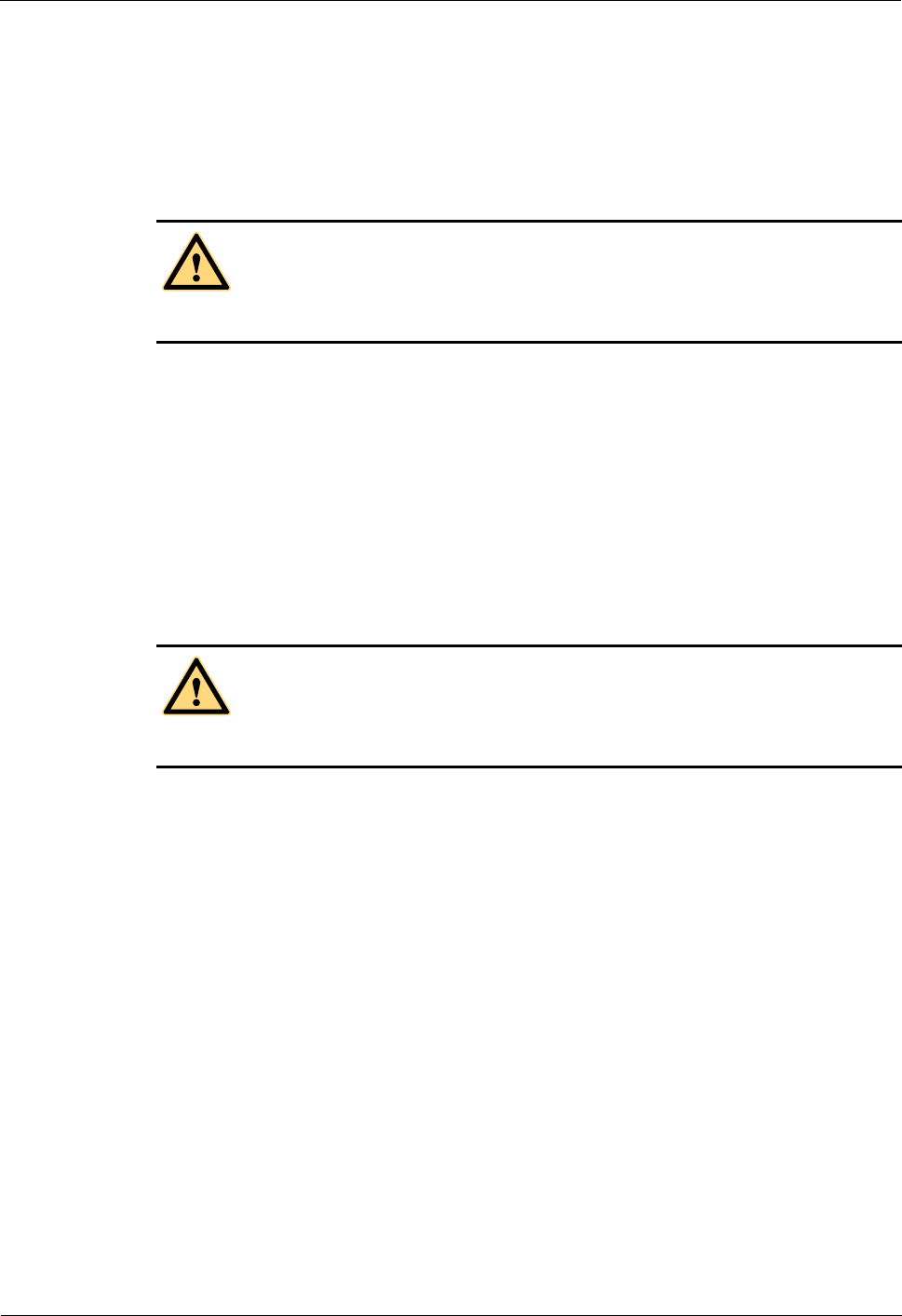
BTS3202E
Compliance and Safety Manual
3 Safety Information
Issue 02 (2012-04-30)
Huawei Proprietary and Confidential
Copyright © Huawei Technologies Co., Ltd
3-13
Before cutting or splicing a fiber, ensure the fiber is disconnected from the optical source.
After disconnecting the fiber, use protecting caps to protect all the optical connectors.
3.7 Working at Heights
WARNING
When working at heights, be careful to prevent objects from falling.
When working at heights, shall comply with the following requirements.
The personnel who work at heights must be trained.
The operating machines and tools shall be carried and handled safely to avoid falling.
Safety protection measures, such as wearing a helmet and a safety belt, shall be taken.
In cold regions, wear worm clothes when performing high-altitude operation.
All lifting appliances must be thoroughly checked before the work is started.
3.7.1 Weight Lifting
WARNING
Do not access the areas under the jib arm and the goods in suspension when lifting weight.
Ensure the operators have completed the related training and are qualified.
Check the weight lifting tools and confirm that the tools are in good condition.
Lift the weight only when the weight lifting tools are firmly fixed onto the
weight-bearing object or the wall.
Use a concise command to avoid incorrect operation.
Ensure the angle between the two cables is less than or equal to 90 degrees during the lift.
(see Figure 3-2).
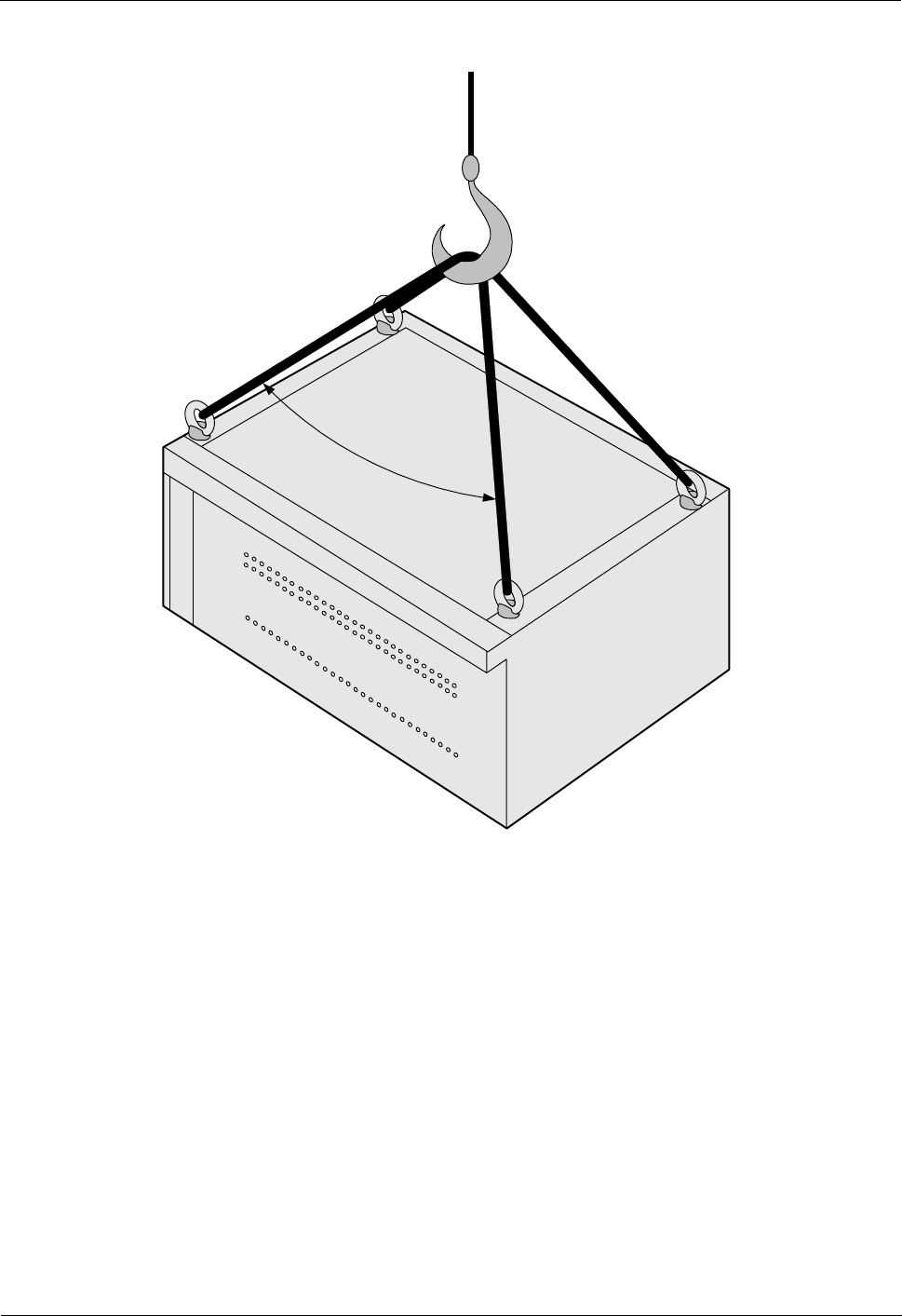
BTS3202E
Compliance and Safety Manual
3 Safety Information
Issue 02 (2012-04-30)
Huawei Proprietary and Confidential
Copyright © Huawei Technologies Co., Ltd
3-14
Figure 3-2 Weight lifting
Maximum 90
3.7.2 Safety Guide on Ladder Use
Checking the Ladder
Before using the ladder, first check if the ladder is in good condition. Make sure that you
know the maximum weight that the ladder can support; overweight on the ladder is strictly
prohibited.
Placing the Ladder
Slant angle is suggested to be 75 degrees. The slant can be measured with the angle square or
with arms. When using a ladder, place the wider end of the ladder on the ground. Otherwise,
take protective measures on the base part of the ladder to avoid skidding. Place the ladder on
stable ground.
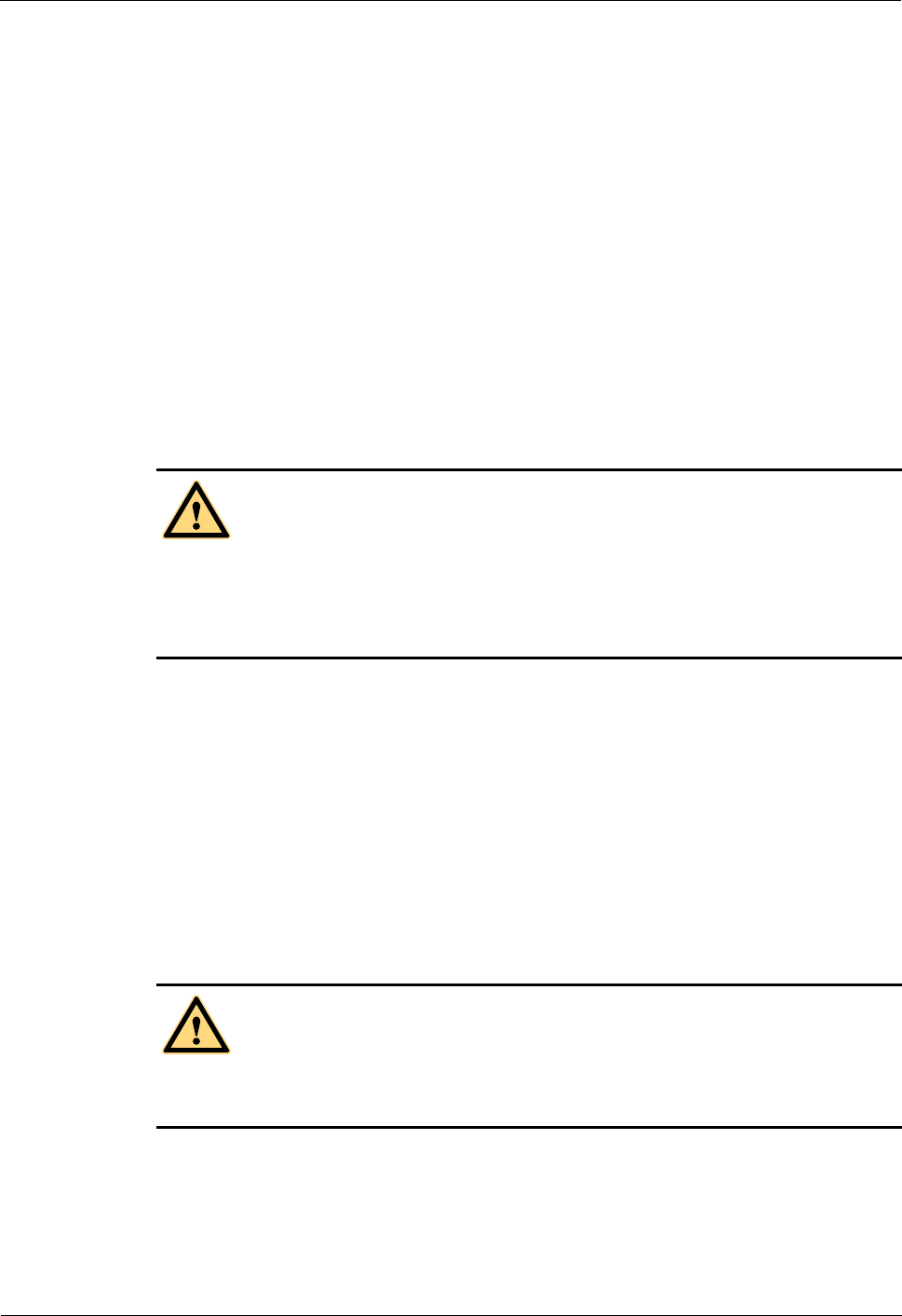
BTS3202E
Compliance and Safety Manual
3 Safety Information
Issue 02 (2012-04-30)
Huawei Proprietary and Confidential
Copyright © Huawei Technologies Co., Ltd
3-15
Climbing the Ladder
When climbing the ladder, note the following.
Ensure the gravity center of your body does not deviate from the ladder edge.
To lessen the danger and ensure the safety, hold your balance on the ladder before any
operation.
Do not climb higher than the forth highest step of the ladder.
If you are about to climb to the top, the length of the ladder shall be one meter higher
than the eave.
3.8 Mechanical Safety
3.8.1 Drilling
WARNING
Drilling on the rack without permission is strictly prohibited. Drilling that does not satisfy
the requirements concerned may damage the wires and cables inside the rack. If the metal
shavings from the drilling fall into the rack, it may result in short circuit of the circuit
boards.
Before drilling a hole on the rack, wear insulation gloves, and remove the cables inside
the rack.
During the drilling, ensure that your eyes are well protected. The hot shavings may
injury to your eyes.
Ensure that the metal shavings do not get into the rack.
Non-standard drilling may damage the electromagnetic shielding performance of the
rack.
After drilling, clean the metal shavings in time.
3.8.2 Sharp Objects
WARNING
When carrying the device by hand, wear protection gloves to avoid injury by sharp
objects.
3.8.3 Handling Fans
Ensure the following:
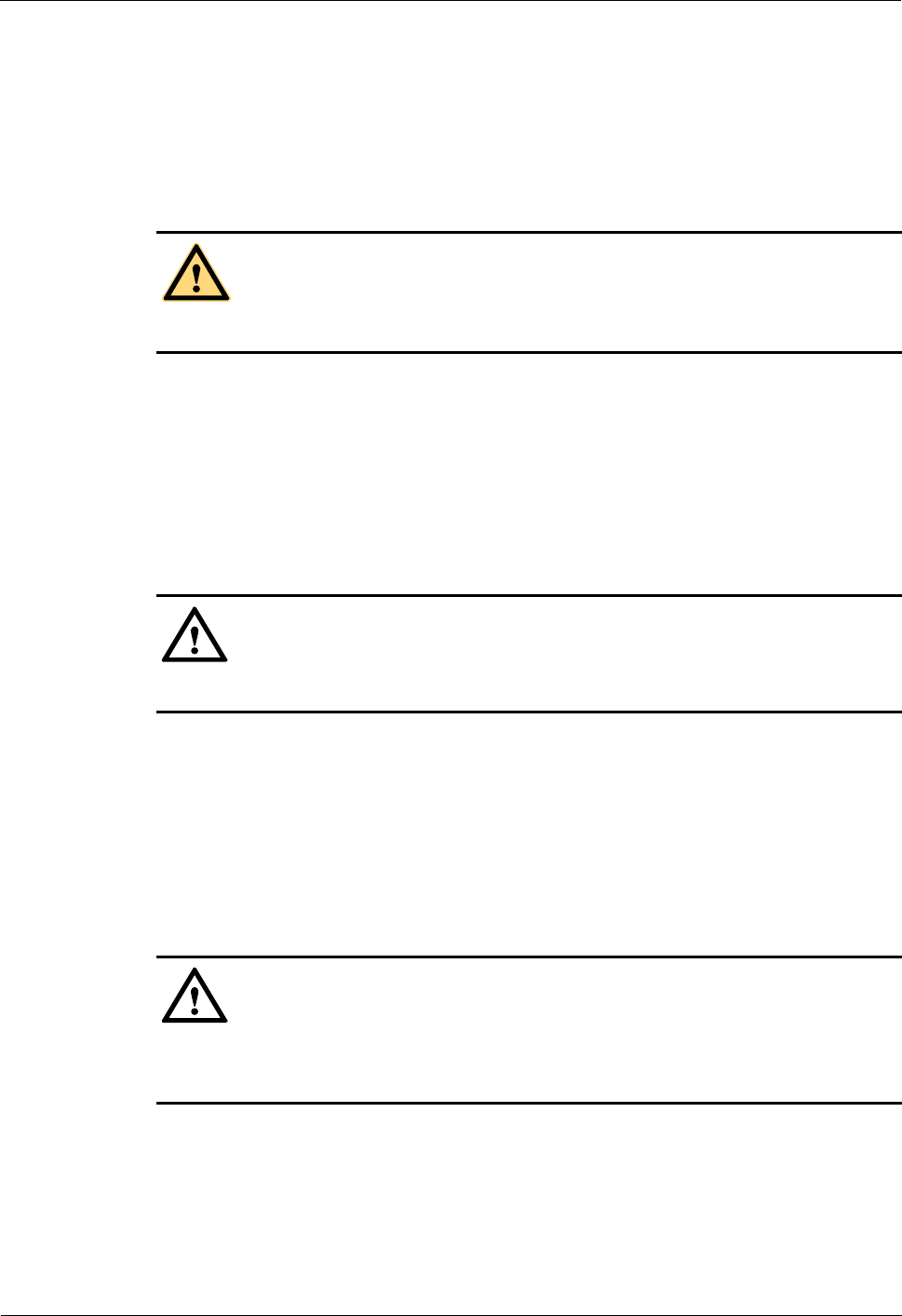
BTS3202E
Compliance and Safety Manual
3 Safety Information
Issue 02 (2012-04-30)
Huawei Proprietary and Confidential
Copyright © Huawei Technologies Co., Ltd
3-16
When replacing a component, place the component, screw, and tool at a safe place to
prevent them from falling into the running fan.
When replacing the ambient equipment around the fan, do not place the finger or board
into the running fan until the fan is switched off and stops running.
3.8.4 Lifting Heavy Objects
WARNING
When lifting heavy objects, do not stand or walk under the arm or the lifted object.
3.9 Miscellaneous
3.9.1 Inserting and Removing a Board
To insert or remove a board, abide by the following requirements:
CAUTION
When inserting a board, handle it gently to avoid distorting pins on the backplane.
Insert the board along the slot guide.
The two sides of one board should not contact another board to avoid short-circuit or
scratch.
When holding a board in hand, do not touch the board circuit, components, connectors,
or connection slots.
3.9.2 Bundling Signal Cables
CAUTION
Bundle the signal cables separately from the strong current cables or high voltage cables.
Maintain a minimum space of 150 mm between adjacent ties.
3.9.3 Cabling Requirements
At a very low temperature, movement of the cable may damage the plastic skin of the cable.
To ensure the construction safety, comply with the following requirements:
When installing cables, ensure that the environment temperature is above 0°C.

BTS3202E
Compliance and Safety Manual
3 Safety Information
Issue 02 (2012-04-30)
Huawei Proprietary and Confidential
Copyright © Huawei Technologies Co., Ltd
3-17
If cables are stored in the place below 0°C, move the cables into a place at a room
temperature and store the cables for more than 24 hours before installation.
Move the cables with care, especially at a low temperature. Do not drop the cables
directly from the vehicle.
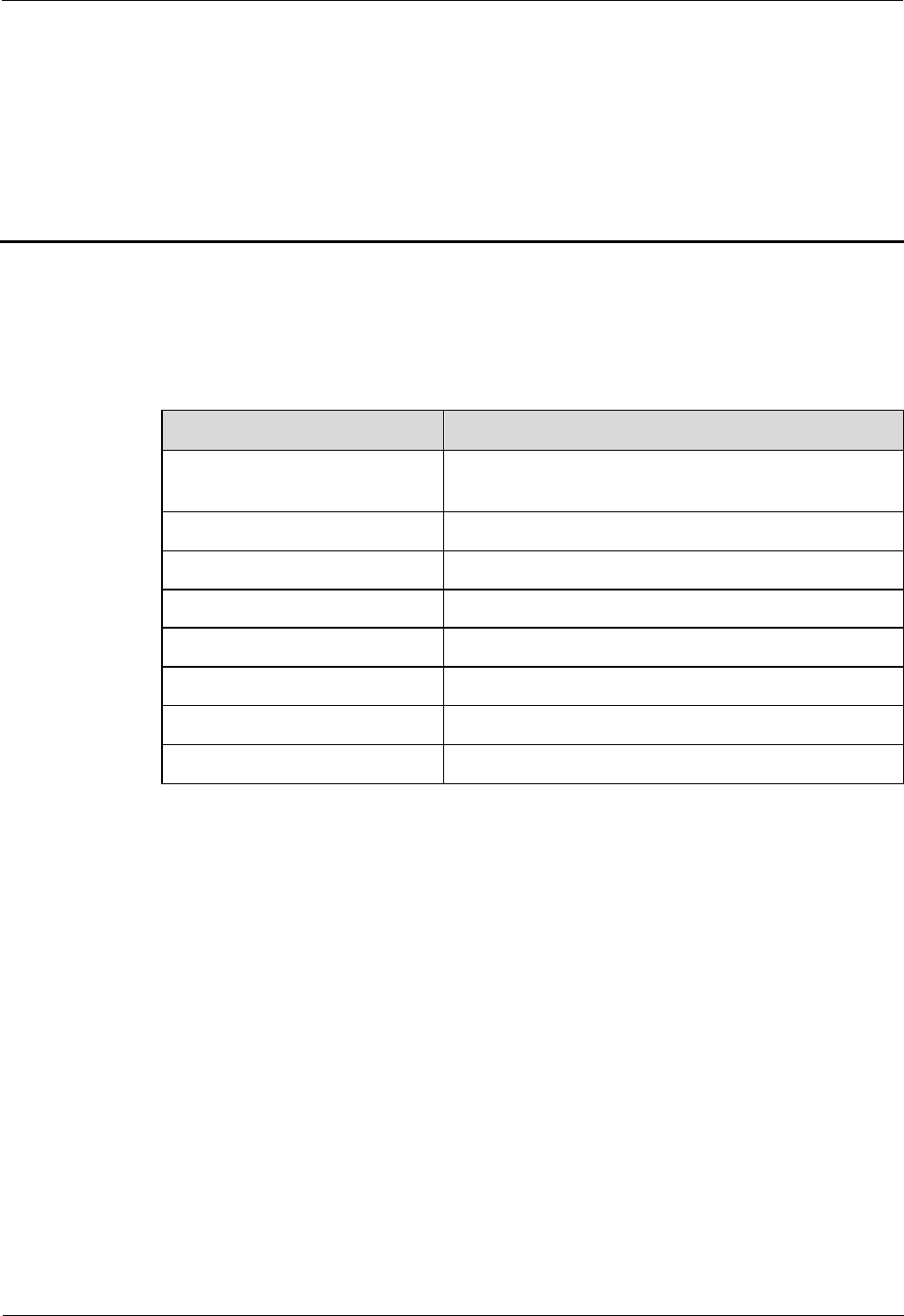
BTS3202E
Compliance and Safety Manual
4 Sicherheitsinformationen
Issue 02 (2012-04-30)
Huawei Proprietary and Confidential
Copyright © Huawei Technologies Co., Ltd
4-1
4 Sicherheitsinformationen
4.1 Inhalt dieses Kapitels
Die folgende Tabelle zeigt den Inhalt dieses Kapitels.
Abschnitt
Beschreibung
4.2 Übersicht
Sicherheitshinweise die Sie beim Aufstellen and
Instandhalten des Huawei Produktes beachten müssen.
4.3 Elektrische Sicherheit
Hinweise zur elektrischen Sicherheit.
4.4 Entzündliche Umgebung
Hinweise zum Umgang mit Entzündliche Umgebung.
4.5 Batterie
Hinweise zum Umgang mit Batterien.
4.6 Strahlung
Hinweise zum Umgang mit Mikrowellen.
4.7 Arbeiten in großen Höhen
Hinweise zum Umgang mit Arbeiten in großen Höhen.
4.8 Mechanische Sicherheit
Hinweise zum Umgang mit Mechanische Sicherheit.
4.9 Sonstiges
Hinweise zum Umgang mit Sonstiges.
4.2 Übersicht
4.2.1 Sicherheitsvorkehrungen
Dieser Abschnitt beschreibt einige Sicherheitsvorkehrungen. Lesen und beachten Sie die
Sicherheitshinweise beim Aufstellen und Instandhalten von Huawei Produkten.
Bevor Sie mit irgendwelchen Arbeiten beginnen, lesen Sie diese Bedienanleitung mit ihren
Sicherheitshinweisen sorgfältig durch, um das Unfallrisiko so klein wie möglich zu halten.
Die mit VORSICHT, WARNUNG und GEFAHR gekennzeichneten Abschnitte in anderen
Unterlagen beinhalten nicht alle zu befolgenden Sicherheitsvorkehrungen. Sie sind nur
Ergänzungen zu den allgemeinen Sicherheitshinweisen. Aus diesem Grund muss das
verantwortliche Personal für das Aufstellen und Instandhalten die Grundlagen für den
sicheren Umgang beherrschen.
Es sind die jeweiligen lokalen Sicherheitsvorschriften zu beachten. Die hier geforderten
Sicherheitsvorkehrungen ergänzen die jeweiligen lokalen Sicherheitsvorschriften.

BTS3202E
Compliance and Safety Manual
4 Sicherheitsinformationen
Issue 02 (2012-04-30)
Huawei Proprietary and Confidential
Copyright © Huawei Technologies Co., Ltd
4-2
Wenn Sie Huawei Produkte benutzen, befolgen Sie bitte alle speziellen und allgemeinen
Sicherheitshinweise von Huawei.
Das für die Aufstellung und Instandhaltung verantwortliche Personal muss eingewiesen
sein in den richtigen Umgang und in die Anwendung der Sicherheitsvorkehrungen. Nur
geschultes und qualifiziertes Personal darf die Geräte aufstellen und instand halten.
4.2.2 Allgemeine Anforderungen
Um das technisch bedingte Restrisiko auf ein Minimum zu begrenzen, ist es unbedingt
erforderlich, die folgenden Regeln zu beachten. Lesen Sie alle Anweisungen sorgfältig durch,
bevor Sie mit dem Arbeiten beginnen.
Aufstellen
Die Einheit (oder das System) darf nur an Orten mit beschränktem Zugang aufgestellt
oder benutzt werden.
Die Ausrüstung kann nur auf Beton oder einer anderen nichtbrennbaren Oberfläche
installiert werden.
Die Ausrüstung muss fest und sicher auf dem Boden oder an geeigneten Gegenständen,
wie z. B. Wänden oder Regalen, angebracht sein. Vergewissern Sie sich vor der
Inbetriebnahme, ob die Verankerung sicher ist.
Beim Aufstellen der Einheit ist zuerst der Erdleiter anzuschließen. Beim Trennen ist er
als letzter zu entfernen.
Decken Sie Lüftungsöffnungen während des Betriebes nicht ab. Halten Sie mindestens
5 cm Abstand zwischen Lüftungsöffnungen und Wänden oder anderen blockierenden
Dingen.
Flügelmuttern und -schrauben sind nach der Erstinstallation und nach Wiederanbringung
von Abdeckungen mit Hilfe von Werkzeug festzuziehen.
Erdung
Betreiben Sie die Ausrüstung niemals ohne Erdung. Trennen Sie das System nicht von
der Erdung.
Die Einheit (oder das System) muss vor der endgültigen Inbetriebnahme geerdet werden.
Der Leitungsquerschnitt des Erdleiters sollte mindestens 0.75 mm² betragen.
Energieversorgung
Mit Wechselstrom betriebenes Modell: Das Gerät arbeitet mit einem
Phase-Nullleiter-System.
Für gleichstromversorgte Geräte: Gleich- und Wechselstromversorgung sind durch
doppelte oder verstärkte Isolierung voneinander zu trennen.
Die vorbereiteten Leitungen sind and die Anschlussstellen anzuschließen. Es dürfen nur
Leitungen mit dem geforderten Mindesttyp angeschlossen werden.
Mit Gleichstrom betriebenes Modell: Das Gerät arbeitet mit Gleichstrom, wobei die
Anforderungen der Norm (IEC 60950-1) für Schutzkleinspannung eingehalten werden
müssen.
Dieses Produkt muss so installiert werden, dass es gegen Kurzschluss (Überstrom)
abgesichert ist. Stellen Sie sicher, dass die Sicherungswerte auf allen Phasen nicht größer
als 120 VAC, 20 A U.S. (240 VAC, 20 A international) bei den mit Wechselstrom
betriebenen Modellen.

BTS3202E
Compliance and Safety Manual
4 Sicherheitsinformationen
Issue 02 (2012-04-30)
Huawei Proprietary and Confidential
Copyright © Huawei Technologies Co., Ltd
4-3
Die Energiezufuhr muss sich einfach und schnell unterbrechen lassen. Dazu ist es
notwendig, dass die entsprechende Trennstelle leicht zugänglich ist.
Für wechselstromversorgte Geräte: Die Stecker-Steckdosen-Verbindung muss jeder Zeit
zugänglich sein, da sie die Netztrennstelle ist.
Mit Wechselstrom betriebenes Modell: Die Netzsteckdose muss in der Nähe der
Ausrüstung installiert werden und jederzeit leicht zugänglich sein.
Da das Gerät mehrere Energiequellen hat, ist es notwendig stets alle Verbindungen zu
unterbrechen, um den energiefreien Zustand zu erreichen.
Das mit Wechselstrom betriebene Modell hat eine Zweiphasen-Sicherung.
Um die Brandgefahr zu minimieren dürfen ausschließlich Nr. 26 AWG oder
leistungsfähigere Telekommunikationskabel verwendet werden.
Personensicherheit
Betreiben Sie das Gerät nicht während Gewitter.
Mit Wechselstrom betriebenes Modell: Um die Sicherheit des Personals und der
Ausrüstung zu gewährleisten, muss der Stecker aus der Steckdose gezogen werden, wenn
die Gefahr eines Blitzeinschlages besteht. Verwenden Sie bei Blitzgefahr keine fest
installierten Steckdosen. Berühren Sie bei Blitzgefahr nicht die Antenne.
Um einen elektrischen Schlag zu vermeiden, dürfen Kleinspannungsschaltungen (SELV)
nicht mit Telefonnetzwerken (TNV) verbunden werden.
Falls Sie das Gestell bewegen oder heben möchten, benutzen Sie die Handgriffe and
Gestellt, oder heben Sie es an von der Unterseite aus an. Es dürfen nicht die Handgriffe
der Steckeinheiten Spannungsversorgung, Lüftung order ähnliche benutzt werden, da sie
das Gewicht des Gestells nicht tragen können.
Versuchen Sie nicht, Baugruppen allein anzuheben oder zu tragen. Für den Transport der
Baugruppen sind mindestens zwei Personen erforderlich. Wenn Sie Baugruppen anheben,
achten Sie bitte darauf, dass Ihr Rücken gerade ist. Sorgen Sie für einen stabilen und
gleichmäßigen Transport der Baugruppen, um Verletzungen zu vermeiden.
Nehmen Sie das Gerät nicht in Betrieb, solange das optische Fenster nicht geschlossen
ist. Der Laserstrahl kann Augenverletzungen verursachen.
Tragen Sie keinen Schmuck oder Uhren, wenn Sie am Gerät arbeiten.
Betreiber
Nur qualifiziertes und erfahrenes Personal darf das Gerät aufstellen, konfigurieren und
auseinander nehmen.
Nur zugelassenes Personal darf das Gerät betreiben.
Jeder Austausch und jede Änderung am System und seinen Teilen (einschließlich der
Software) darf nur vom qualifizierten und bevollmächtigten Fachpersonal von Huawei
durchgeführt werden.
Jeder Fehler und jede Störung die die Sicherheit verletzen könnten, sind sofort den
verantwortlichen Personen zu melden.
Nur qualifiziertes Fachpersonal darf Sicherheitseinrichtungen beseitigen oder außer
Betrieb setzen, und Fehlersuche oder Instandhaltungsarbeiten durchführen.
Alle Teile dieses Handbuches sind zu beachten. Das Handbuch dient gleichzeitig als Ratgeber
bei der Auswahl von zusätzlichen Messinstrumenten und Testvorrichtungen.
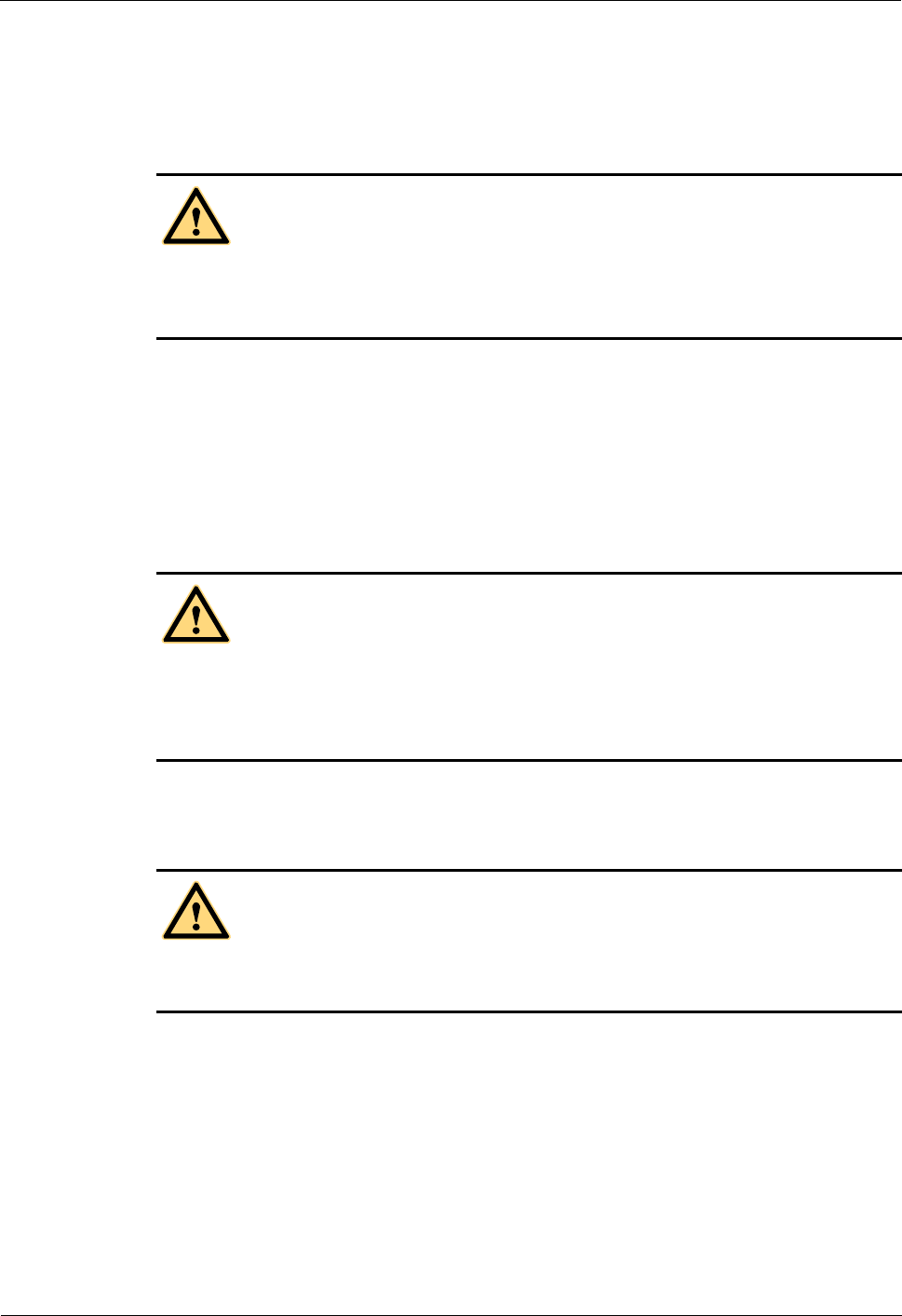
BTS3202E
Compliance and Safety Manual
4 Sicherheitsinformationen
Issue 02 (2012-04-30)
Huawei Proprietary and Confidential
Copyright © Huawei Technologies Co., Ltd
4-4
4.3 Elektrische Sicherheit
4.3.1 Hochspannung
GEFAHR
Hochspannungsleitungen stellen die für die Arbeit der Ausrüstung erforderliche Energie zur
Verfügung. Direkter oder indirekter Kontakt (z. B. durch feuchte Gegenstände) mit
Hochspannung und Wechselstromversorgung kann zu tödlichen Unfällen führen.
Während des Aufstellens der Wechselstromversorgungseinheit sind die lokal gültigen
Sicherheitsvorschriften einzuhalten. Das Personal für das Aufstellen der Wechselstrom-
einheit muss für Arbeiten and Hochspannung und Wechselstrom qualifiziert sein.
Tragen Sie keine elektrisch leitende Gegenstände wie Uhren, Armreifen, Ketten oder
Ringe.
Sollte sich Wasser im Baugruppenträger befinden oder der Baugruppenträger feucht sein,
ist die Energiezufuhr sofort zu unterbrechen und das System abzuschalten.
WARNUNG
Die Nichtbeachtung der Sicherheitsvorschriften bei der Arbeit mit Hochspannung kann zu
Feuer und elektrischem Schlag führen. Deshalb muss die Verlegung von Leitungen und
Verbindungen den örtlichen Anforderungen und Sicherheitsvorschriften entsprechen. Arbeiten
mit Hochspannung dürfen nur von qualifiziertem Fachpersonal durchgeführt werden.
4.3.2 Gewitter
GEFAHR
Arbeiten mit Hochspannung und Wechselstrom oder Arbeiten auf Stahltürmen und Masten
während eines Gewitters sind verboten.
Das elektromagnetische Feld, das während eines Gewitters entsteht, kann die Elektronik
beschädigen. Um die Ausrüstung vor Beschädigung durch Blitzschlag zu schützen, ist eine
ordnungsgemäße Erdung erforderlich.
4.3.3 Werkzeuge
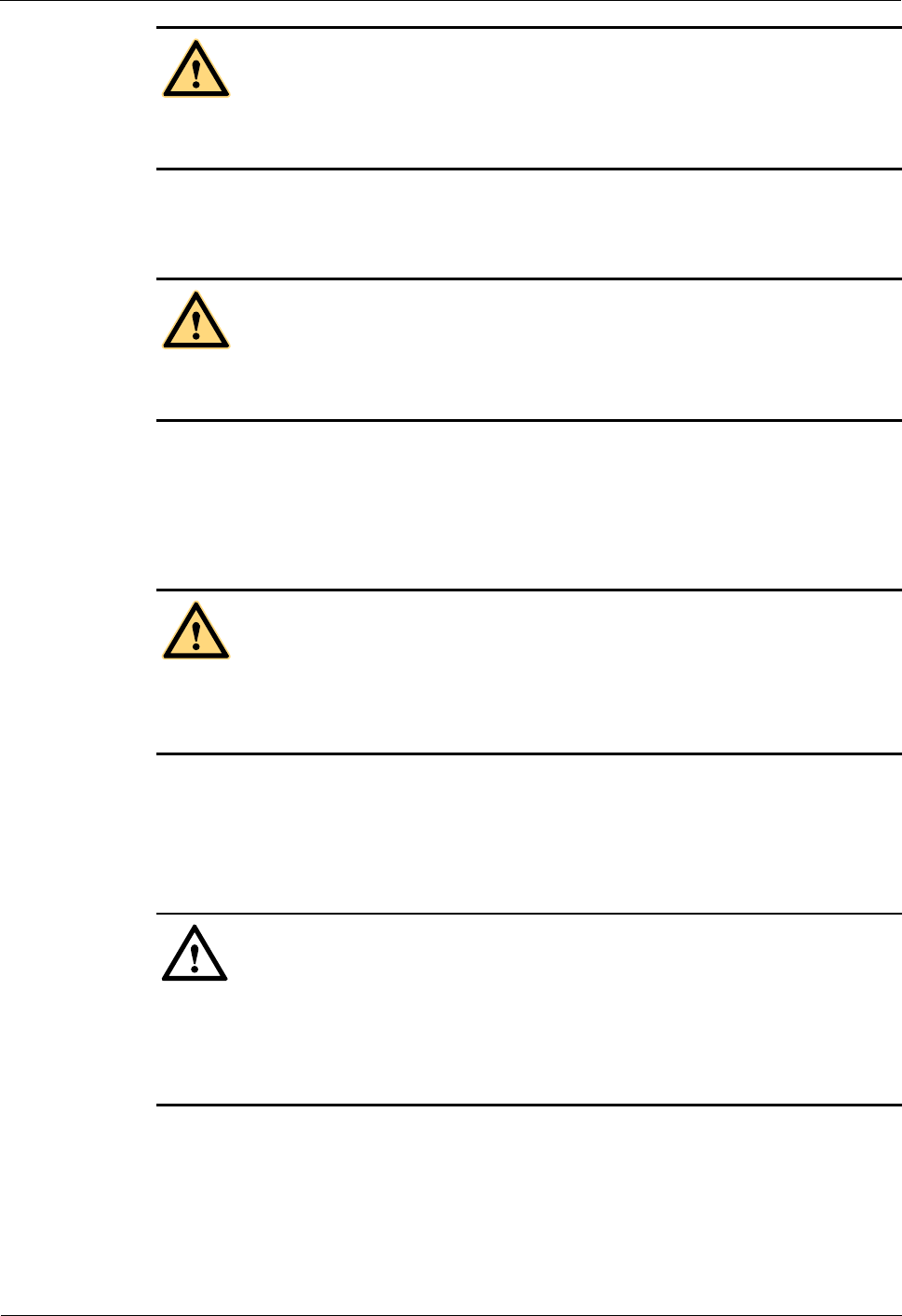
BTS3202E
Compliance and Safety Manual
4 Sicherheitsinformationen
Issue 02 (2012-04-30)
Huawei Proprietary and Confidential
Copyright © Huawei Technologies Co., Ltd
4-5
WARNUNG
Für Arbeiten mit Hochspannung und Wechselstrom sind Spezialwerkzeuge zu verwenden. Es
ist nicht erlaubt, herkömmliche Werkzeuge oder Werkzeuge des Bedienpersonals zu benutzen.
4.3.4 Hoher Kriechstrom
WARNUNG
Erden Sie das Gerät bevor Sie es anschalten; ansonsten sind das betreibende Personal und das
Gerät in Gefahr.
Wenn sich die Markierung "hoher Kriechstrom" am Leistungsanschluss des Gerätes befindet,
müssen Sie das Gerät erden, bevor Sie es anschalten.
4.3.5 Zuleitung
WARNUNG
Das Entfernen und Anbringen von Zuleitungen ist strengstens verboten. Kurzschlüsse
zwischen innerem und äußerem Leiter können Lichtbögen oder Funkenflug verursachen, was
zu Feuer oder einer Augenverletzung führen kann.
Das System muss stets abgeschaltet werden, bevor die Zuleitung angebracht oder
entfernt wird.
Überprüfen Sie vor dem Anbringen der Zuleitung immer, ob das von Ihnen verwendete
Kabel den Anforderungen entspricht.
VORSICHT
Für mit Wechselstrom betriebene Ausrüstung benutzen Sie bitte eine 0.75 mm2 oder 18
AWG Zuleitung.
Es sind Typ H03VV-F oder eine leichte PVC Schlauchleitung entsprechend IEC 60227 zu
benutzen.
4.3.6 Sicherung
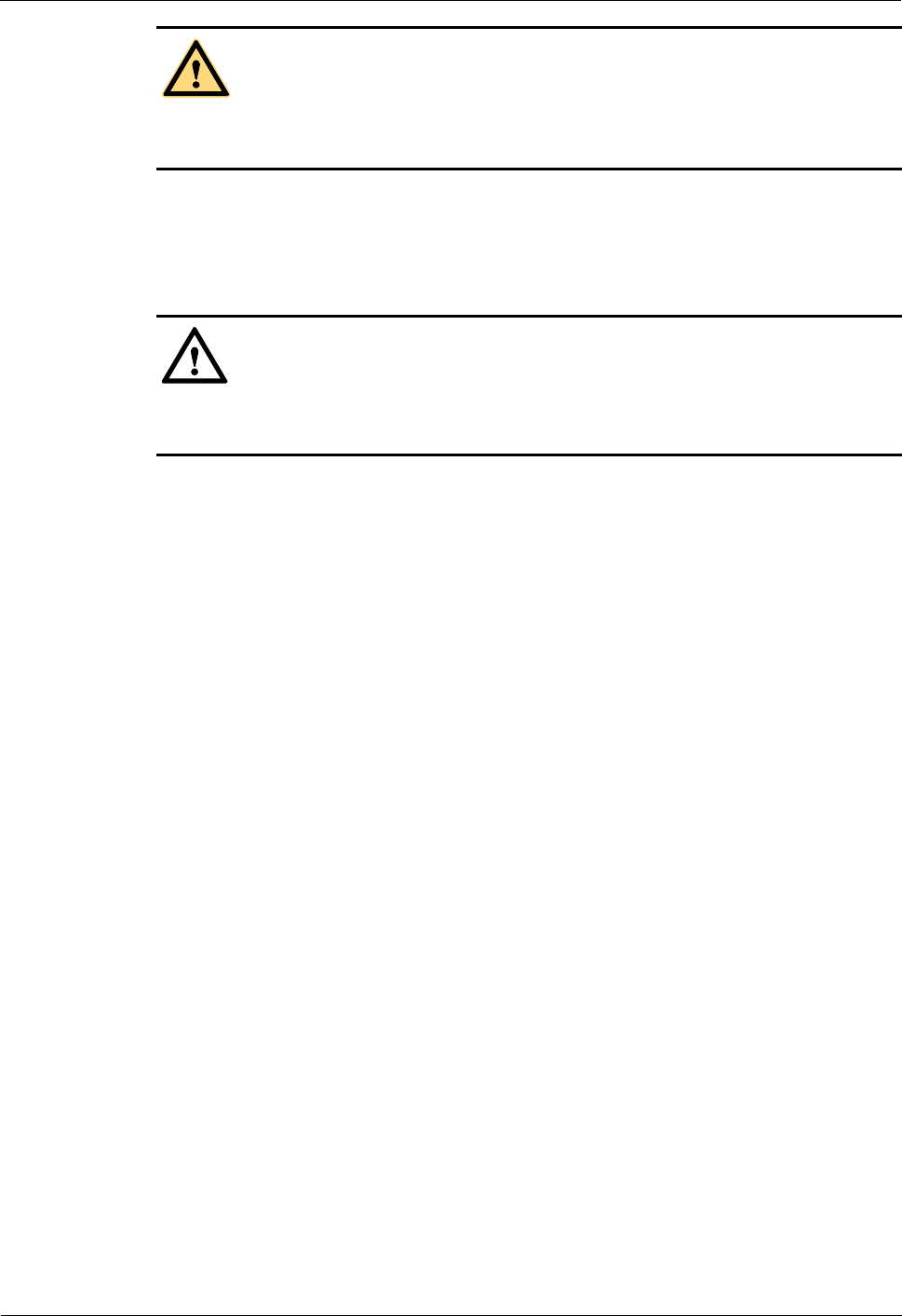
BTS3202E
Compliance and Safety Manual
4 Sicherheitsinformationen
Issue 02 (2012-04-30)
Huawei Proprietary and Confidential
Copyright © Huawei Technologies Co., Ltd
4-6
WARNUNG
Ersetzen Sie die Sicherung bei Bedarf immer nur mit einem Sicherungstyp, der die
gleichen technischen Daten besitzt.
4.3.7 Elektrostatische Entladung
VORSICHT
Die statische Aufladung des menschlichen Körpers kann bei Entladung empfindliche Bauteile
auf den Leiterplatten, wie z. B. integrierte Schaltkreise (ICs), zerstören.
Durch folgende Handlungen generiert der menschliche Körper elektrostatische Felder:
Bewegung des Körpers
Reibung der Kleidung
Reibung zwischen Schuhen und Erdboden
Halten von Plastikgegenständen in der Hand
Ein elektrostatisches Feld bleibt am menschlichen Körper für lange Zeit erhalten.
Wenn Sie Geräte anfassen müssen, während Sie Leiterplatten oder ASICs halten, sollten Sie
Entladungsarmbänder tragen. Dies verhindert, dass empfindliche Bauteile durch
elektrostatische Entladung zerstört werden.
Figure 3-1 zeigt wie das Entladungsarmband getragen wird.
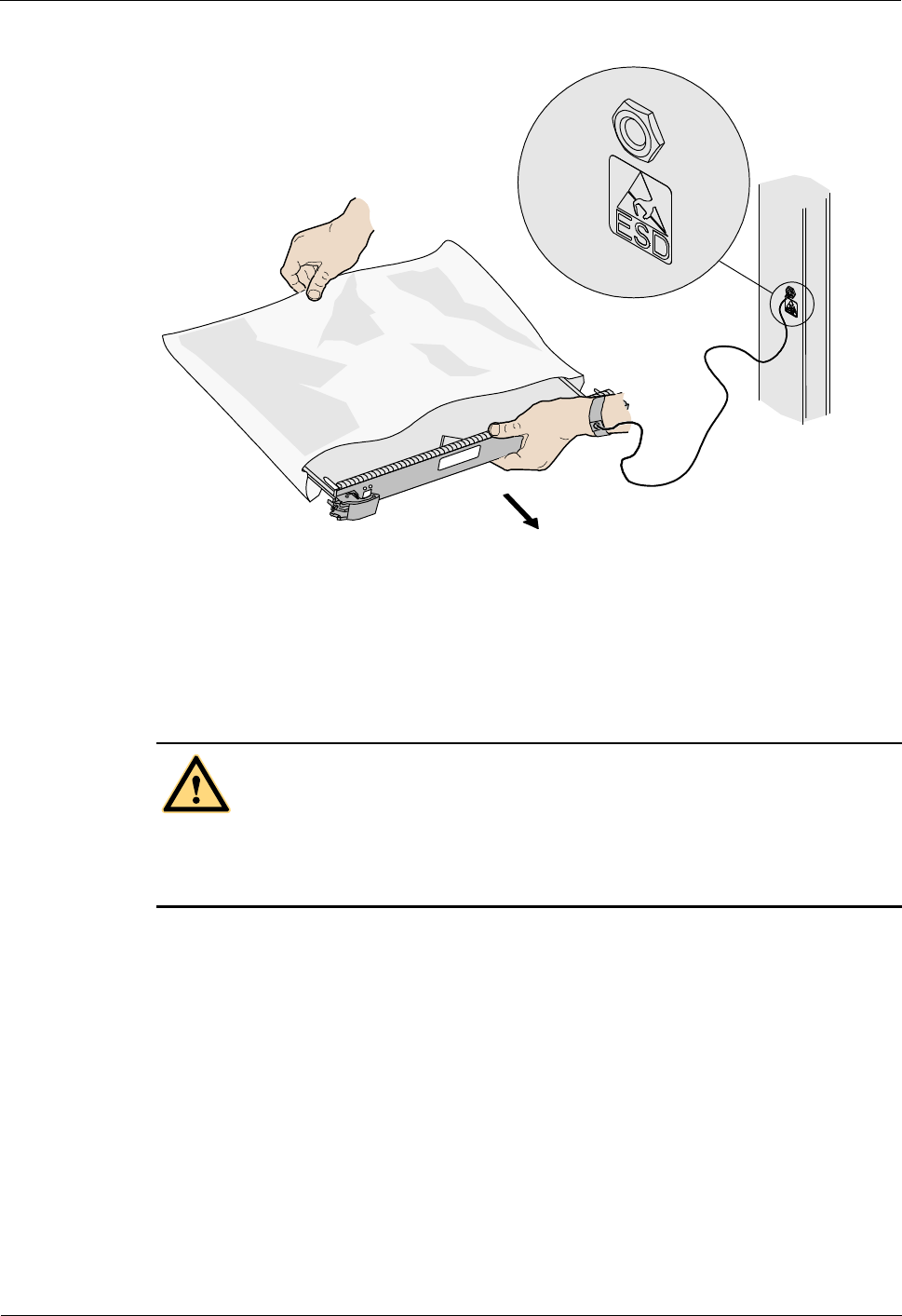
BTS3202E
Compliance and Safety Manual
4 Sicherheitsinformationen
Issue 02 (2012-04-30)
Huawei Proprietary and Confidential
Copyright © Huawei Technologies Co., Ltd
4-7
Figure 4-1 Darstellung des Tragens eines Entladungsarmbandes
4.4 Entzündliche Umgebung
GEFAHR
Stellen Sie das Gerät nicht bei Umgebungsbedingungen auf, wo entzündliche und explosive
Luft oder Nebel vorherrschen. Nehmen Sie bei diesen Umgebungsbedingungen das Gerät
nicht in Betrieb.
Jegliches Betreiben des elektrischen Gerätes bei entzündlichen Umgebungsbedingungen
verursacht Gefahr.
4.5 Batterie
4.5.1 Speicherbatterie
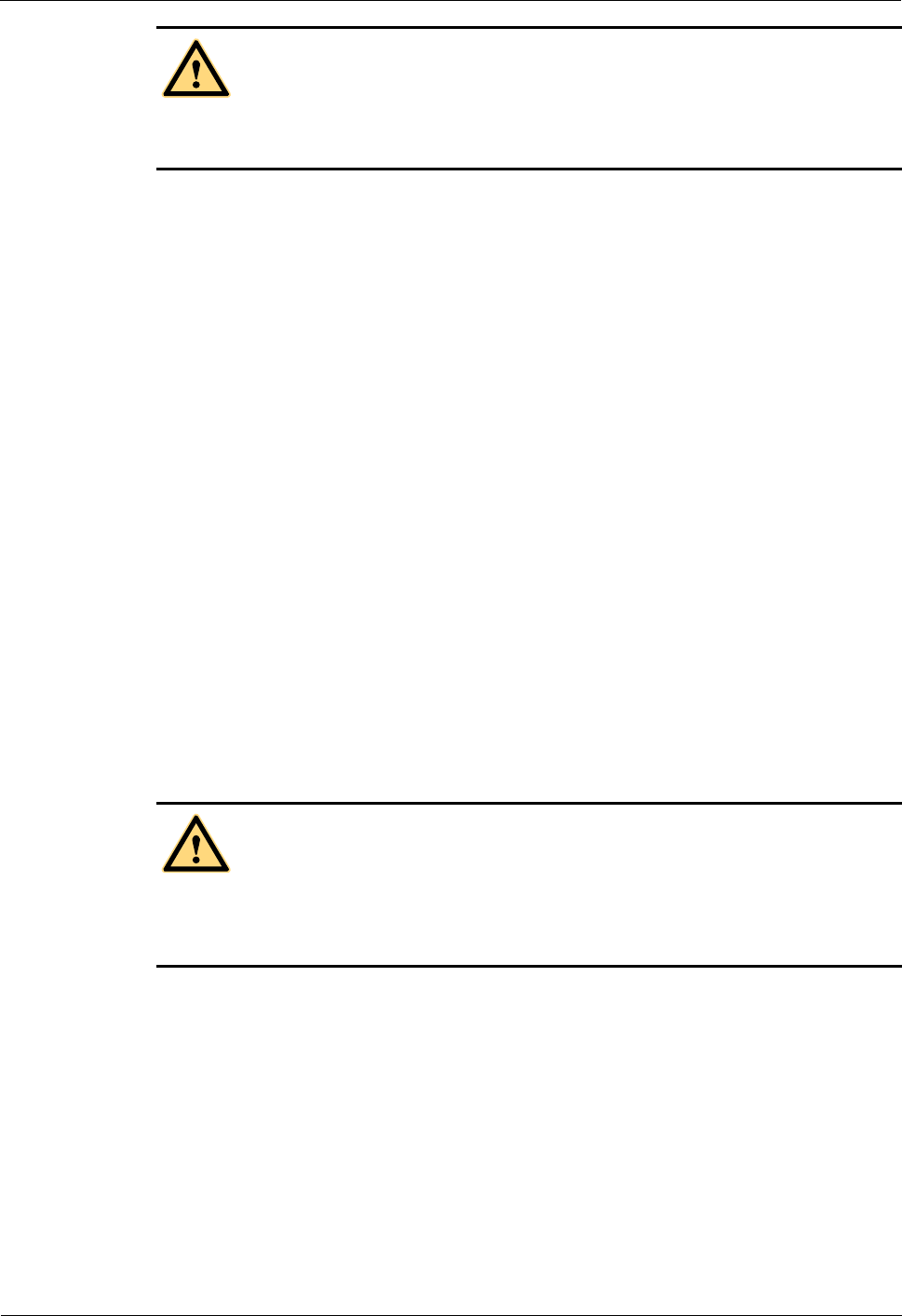
BTS3202E
Compliance and Safety Manual
4 Sicherheitsinformationen
Issue 02 (2012-04-30)
Huawei Proprietary and Confidential
Copyright © Huawei Technologies Co., Ltd
4-8
GEFAHR
Machen Sie sich mit den Sicherheitsvorschriften für das Arbeiten mit der Batterie und für die
korrekten Anschlussbestimmungen der Batterie vertraut.
Die nicht ordnungsgemäße Behandlung der Batterie birgt Gefahren.
Während der Benutzung:
Schützen Sie die Batterie vor Kurzschluss, und
Verhindern Sie das Über- und Auslaufen der Elektrolyt-Flüssigkeit.
Das Überlaufen des Elektrolyts kann zur Folge haben, dass die Metallteile und die
Leiterplatten korrodieren, was zu Kurzschlüssen in den Leiterplatten und zu einer schweren
Beschädigung der Ausrüstung führt.
Allgemeine Arbeitsweise
Beachten Sie folgendes während des Umgangs mit Batterien:
Tragen Sie keine metallischen Gegenstände wie Uhren, Armreifen, Ketten und Ringe.
Benutzen Sie speziell isoliertes Werkzeug.
Tragen Sie eine Schutzbrille und seien Sie aufmerksam.
Tragen Sie Gummihandschuhe und -schürze für den Fall des Überlaufens von
Elektrolyt-Flüssigkeit.
Halten Sie stets die Anschlüsse noch oben. Kippen Sie die Batterien nicht, und drehen
Sie die Batterie nicht um.
Kurzschluss
WARNUNG
Der Kurzschluss der Batterie kann Verletzungen zur Folge haben. Auch wenn die Spannung in
der Batterie generell gering ist, kann durch den Kurzschluss kurzzeitig ein hoher
Ausgleichsstrom fließen.
Halten Sie metallische Gegenstände von der Batterie fern, die einen Kurzschluss verursachen
könnten. Falls die Benutzung von diesen Gegenständen unumgänglich ist, klemmen Sie die
Batterie erst ab, bevor Sie Ihre Arbeiten durchführen.
Gesundheitsschädliches Gas
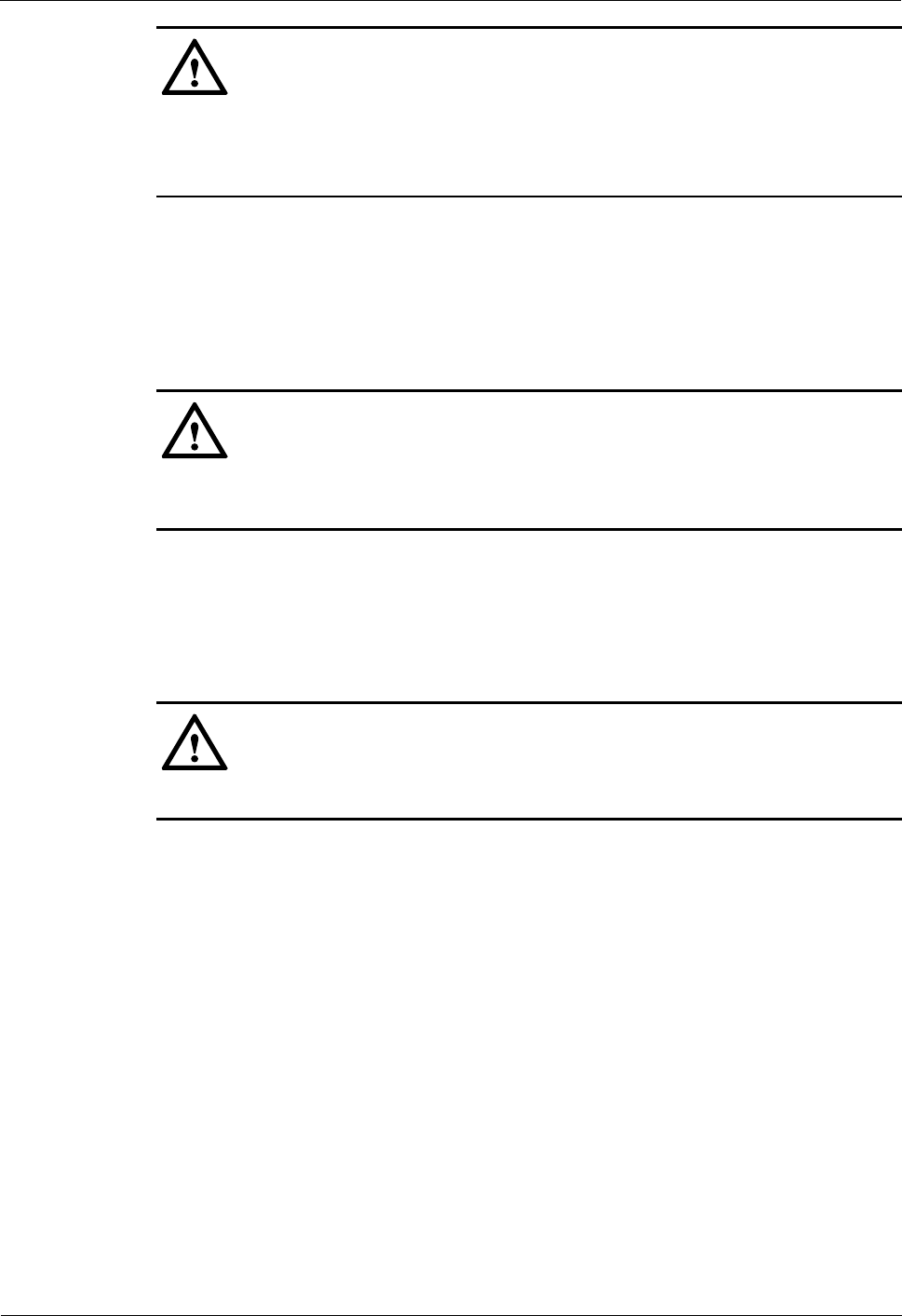
BTS3202E
Compliance and Safety Manual
4 Sicherheitsinformationen
Issue 02 (2012-04-30)
Huawei Proprietary and Confidential
Copyright © Huawei Technologies Co., Ltd
4-9
VORSICHT
Benutzen Sie keine unversiegelten Blei-Säure-Akkus, da entweichende Gase zur
Zündquelle werden können und Korrosion am Gerät verursachen.
Stellen Sie die Batterie waagerecht auf, und schließen Sie sie fachgerecht an.
Der Batterie entströmt während des Gebrauchs entflammbares Gas. Deshalb muss die Batterie
in einem Raum mit ausreichender Luftzirkulation untergebracht werden. Vorkehrungen gegen
Feuer sollten ebenfalls getroffen werden.
Einfluss hoher Temperaturen
VORSICHT
Wird die Batterie hohen Temperaturen ausgesetzt, kann es zur Verformung oder Beschädigung
der Batterie sowie zum Auslaufen des Elektrolyts kommen.
Falls die Batterietemperatur 60 C übersteigt, sollten Sie umgehend überprüfen, ob Säure
ausgelaufen ist. Sollte dies der Fall sein, ist die Säure sofort zu neutralisieren.
Säure
VORSICHT
Wenn Säure ausgelaufen ist, muss diese sofort absorbiert und neutralisiert werden.
Achten Sie beim Ein- und Ausbau einer Batterie darauf, ob diese undichte Stellen hat und so
auslaufende Säure zu Beschädigungen führen kann. Sollten Sie Tropfen oder Lachen
ausgelaufener Säure finden, benutzen Sie bitte die nachstehenden Substanzen zum
Absorbieren und Neutralisieren der Säure.
Natriumbikarbonat (Backpulver): NaHCO3
Natriumkarbonat (Soda): Na2CO3
Bei der Benutzung von Ameisensäure beachten Sie bitte die vom Zulieferer der Batterie zur
Verfügung gestellten Hinweise.
4.5.2 Lithiumbatterie
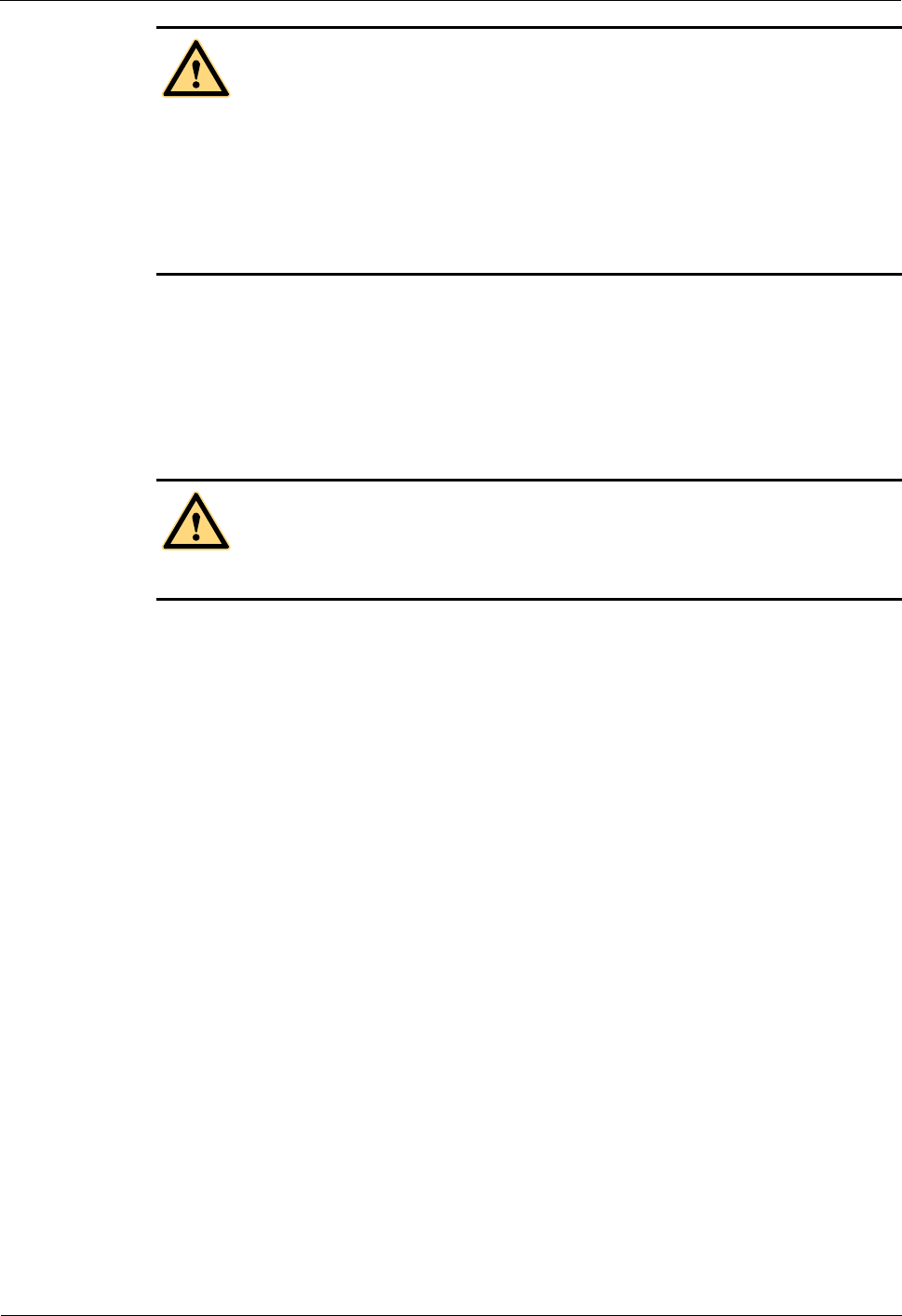
BTS3202E
Compliance and Safety Manual
4 Sicherheitsinformationen
Issue 02 (2012-04-30)
Huawei Proprietary and Confidential
Copyright © Huawei Technologies Co., Ltd
4-10
WARNUNG
Bei unsachgemäßem Austausch der Batterie besteht die Gefahr einer Explosion. Ersetzen
Sie die Batterie stets nur mit dem gleichen oder einem ähnlichem, vom Hersteller
empfohlenen Batterietyp.
Werfen Sie die gebrauchten Batterien nicht in den Hausmüll, sondern entsorgen Sie diese
nach den vom Hersteller gegebenen Anweisungen.
Entsorgen Sie die Lithiumbatterien auf keinen Fall durch Verbrennen!.
4.6 Strahlung
4.6.1 Elektromagnetisch Fangen Sie Explosure auf
WARNUNG
Radiosignale hoher Intensität sind schädlich für den menschlichen Körper.
Vor der Installation und Instandhaltung einer Antenne auf einem Stahlturm oder einem Mast
mit einer großen Anzahl weiterer Sendeantennen, müssen alle Sendeantennen abgeschaltet
werden.
Einleitung
Die Sende-/Empfangsanlage verursacht radiofrequente Strahlung (Strahlungsgefahr). Im
folgenden werden Empfehlungen zum Aufstellen und Betreiben von Sende-/Empfangsanlagen
gegeben.
Betreiber von Sende-/Empfangsanlagen müssen die lokalen Bestimmungen für
Sende-/Empfangsanlagen einhalten.
Grenzwerte und Richtlinien für elektromagnetische Felder
Es gibt zahlreiche nationale und internationale Vorschriften, Normen und Richtlinien über die
Belastung durch elektromagnetische Felder. Mehrere europäische Staaten haben die
Empfehlungen des Rates der Europäischen Union angenommen. Diese waren veröffentlicht
am 12. Juli 1999 als Grenzwerte der Belastung der Bevölkerung durch Elektromagnetische
Felder (1999/519/EG). Die Empfehlung basiert auf der veröffentlichten Richtlinie der
Internationalen Kommission zum Schutz gegen Nichtionisierende Strahlungen (ICNIRP).
Die folgende Tabelle vergleicht die Anforderungen und Umsetzung in verschiedenen Ländern.

BTS3202E
Compliance and Safety Manual
4 Sicherheitsinformationen
Issue 02 (2012-04-30)
Huawei Proprietary and Confidential
Copyright © Huawei Technologies Co., Ltd
4-11
Land
Elektrische
Feldstärke
bis 950 MHz
S Energie-
flussdichte
bis 950 MHz
Elektrische
Feldstärke
bis1850 MHz
S Energie-
flussdichte
bis
1850 MHz
ICNIRP
International
42 V/m
4,75 W/m²
59 V/m
9,25 W/m²
Europa
(1999/519/EC)
42 V/m
4,75 W/m²
59 V/m
9,25 W/m²
Italien
Dekret Nr. 381,
1998
6 V/m
0,095 W/m²
6 V/m
0,095 W/m²
Schweiz
Verord. 1999
4 V/m
0,043 W/m²
6 V/m
0,096 W/m²
Die empfohlenen Richtwerte dienen der Bewertung, ob die Basiswerte der Stärke
elektromagnetischen Felder, denen Menschen ausgesetzt sein dürfen, überschritten werden.
Die Basiswerte für die Belastung mit elektromagnetischen Feldern wurden nach Auswertung
von nachgewiesenen Auswirkungen auf die Gesundheit des Menschen unter Berücksichtigung
von biologischen Aspekten festgesetzt
Standorte von Antennen der Basisstation
Antennen für Bodenstationen als Strahlungsquelle sind wie folgt errichtet:
Auf freistehenden Masten mit Höhen bis zu 30 m oder
Auf Masten auf Gebäudedächern oder
In geringen Ausnahmen an Gebäudewänden.
Im Allgemeinen werden die Antennen nicht in einer Höhe unterhalb von 10 m Höhe
angebracht. Die Energie wird im Normalfall in einem horizontal verlaufendem Hauptstrahl,
welcher sich nur gering abwärts neigt, ausgesandt. Die restliche Energie formt sich zu
schwachen Strahlen zu beiden Seiten des Hauptstrahls. Der Hauptstrahl erreicht den Erdboden
erst in einem Abstand von 50 m - 200 m von der Antenne.
Der höchste Energieausstoß wird in der Nähe der Antenne sowie in der Ausrichtungsebene der
Antenne erreicht.
Verbotene Zonen
Die Standorte der Antennen müssen so gewählt werden, dass kein unbefugter Zutritt zu
dem Gebiet, wo die Mikrowellen-Strahlung höhere Grenzwerte als oben angeführt
erreicht, möglich ist.
Sind Gebiete mit erhöhten Grenzwerten an Mikrowellen für das Personal zugänglich,
müssen alle Mitarbeiter über diese entsprechenden Gebiete unterrichtet werden. Es muss
gewährleistet sein, dass die Mitarbeiter die Sender abschalten können, bevor sie diese
Gebiete betreten. Gebiete mit erhöhten Grenzwerten an Mikrowellen müssen nicht
zwangsläufig existieren. Wenn es sie jedoch gibt, sind diese Gebiete auf einen Umkreis
von 10m um die Antennen begrenzt.

BTS3202E
Compliance and Safety Manual
4 Sicherheitsinformationen
Issue 02 (2012-04-30)
Huawei Proprietary and Confidential
Copyright © Huawei Technologies Co., Ltd
4-12
Jede der verbotenen Zonen muss mit einer unüberwindbaren Absperrung abgegrenzt
werden. Des Weiteren müssen sowohl für die Mitarbeiter als auch für die Öffentlichkeit
leicht verständliche Warnschilder angebracht werden.
Richtlinien für das Montieren der Antennen
Bei Dachantennen: Die Antennen sind oberhalb von Dachflächen anzubringen, auf denen
sich Personen aufhalten könnten.
Bei Dachantennen: Die Antennen sind abseits von Dachflächen, wie Dachzugängen,
Telefonwartungsanlagen und Spannungsverteilern anzubringen, auf denen sich Personen
am wahrscheinlichsten aufhalten könnten.
Richtantennen sollen am Rand der Dächer befestigt werden und stets in vom Gebäude
abweisender Richtung zeigen.
Berücksichtigen Sie bei der Wahl des Antennenstandortes die gegenseitige Beeinflussung
der Antennen.
Treffen Sie besondere Vorsichtsmaßnahmen, um Hochleistungsantennen so anzubringen,
dass Unbefugten der Zutritt nicht möglich ist.
Antennen sind so entfernt wie möglich anzubringen, auch wenn dies die Abdeckung
beeinträchtigen könnte.
Besondere Vorsicht ist geboten, wenn Antennen verschiedener Betreiber nahe zueinander
montiert werden sollen. Insbesondere trifft dies für Hochleistungsradio- und
Fernsehantennen zu. Örtliche Gegebenheiten bieten sich oftmals für das Montieren
unterschiedlicher Antennen an, jedoch besteht die Gefahr von Sicherheitsproblemen
infolge erhöhter Mikrowellenstrahlung.
Beim Montieren von Antennen in der Nähe von Schulen und Krankenhäusern sind
besondere Vorsichtsmaßnahmen zu beachten.
Standort des Messkopfes
Die Send-/Empfangsanlage selbst schirmt Radiowellen ab. Die Anlage wurde auf Einhaltung
der Strahlungsanforderungen gemäß EN 301 502 geprüft. Die Grenzwerte liegen weit unter
einer schädlichen Belastung. Die Sende-/Empfangsanlage stellt damit kein Risiko für die
Bevölkerung und Personal unter normalen Betriebsbedingungen dar. Es kann jedoch durch
ungeeignete Antennenkabel und Fehlfunktionen zur Überschreitung der Grenzwerte kommen.
Sende-/Empfangsanlagen dürfen nicht für die Bevölkerung zugänglich sein. Der Zutritt
ist nur ausgebildetem Personal zu gestatten.
Zugänge sind eindeutig kenntlich zu machen. Z. B. kann ein Warnhinweis für das
Personal angebracht werden, dass das Personal einer höheren Strahlungsbelastung
ausgesetzt sein könnte.
Sende-/Empfangsanlagen sind regelmäßig zu überprüfen.
Voraussage der Höhe von elektromagnetischen Feldern
Die im folgenden beschriebene Methode zeigt eine Möglichkeit, die Höhe der von einem
Messkopf ausgehenden Mikrowellenstrahlung theoretisch vorauszusagen. Präzise Aussagen
sind nur möglich durch Messungen oder durch komplexe Berechnungen, welche auch die
Vielschichtigkeit der Umgebung, wie z. B. Erdzusammensetzung, nahe stehende Gebäude und
andere Hindernisse, die Reflexionen und Streuung des elektromagnetischen Feldes
verursachen, berücksichtigen.
Die maximale Ausgangsleistung eines Messkopfes (in EIRP angegeben) ist gewöhnlich durch
die Lizenzbedingungen des Netzbetreibers begrenzt.
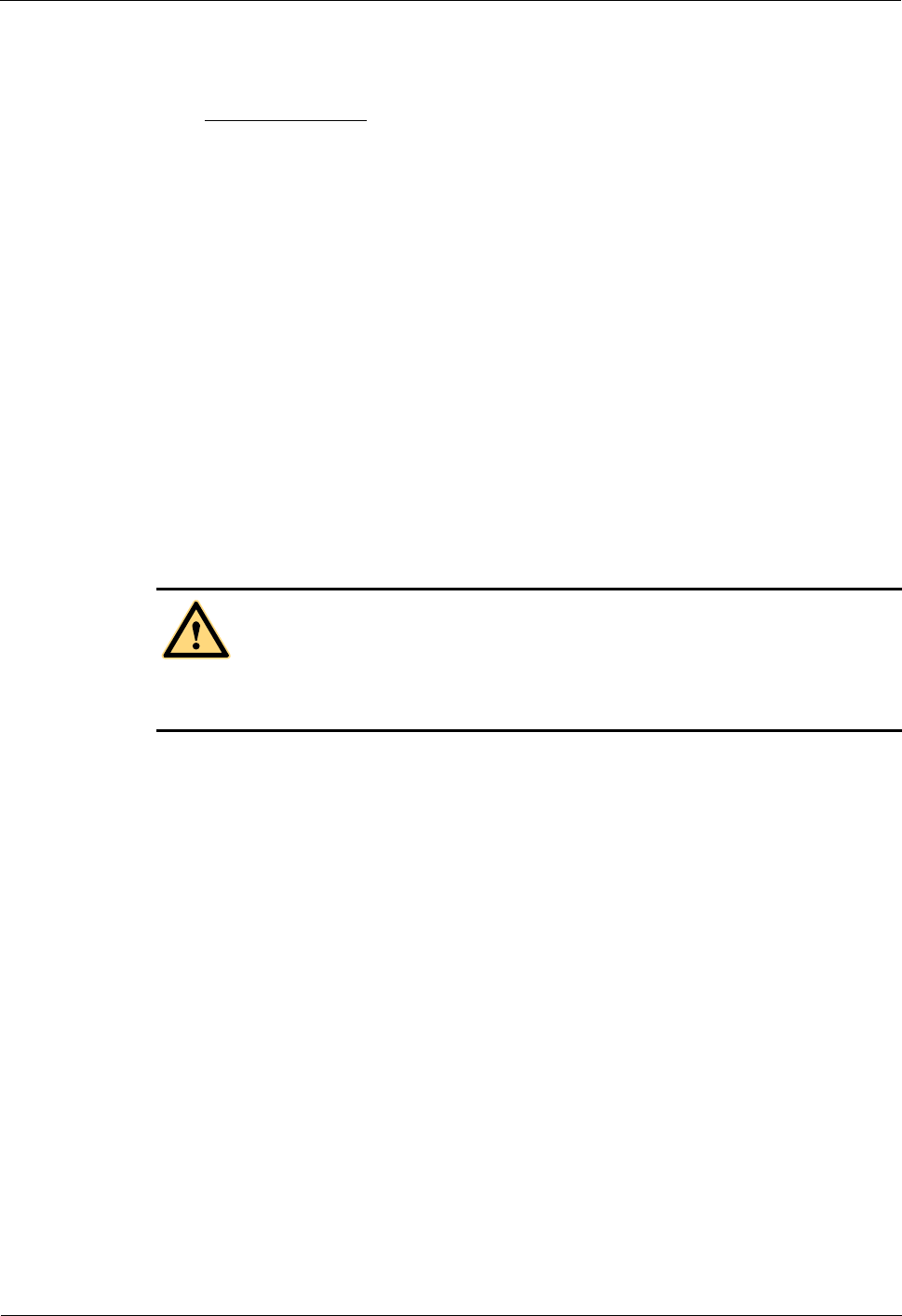
BTS3202E
Compliance and Safety Manual
4 Sicherheitsinformationen
Issue 02 (2012-04-30)
Huawei Proprietary and Confidential
Copyright © Huawei Technologies Co., Ltd
4-13
Eine grobe Abschätzung der zu erwartenden Energieflussdichte in einem bestimmten Punkt
kann mit Hilfe der nachstehenden Gleichung ermittelt werden:
)(4
)(
2mr
GWP
Snumeric
Zeichenerklärung:
P = maximale Ausgangsleistung in W
Gnumeric = Zeitfaktor (Berechnung siehe unten)
r = Abstand zwischen der Antenne und dem entsprechend Punkt in m
Berechnung des Zeitfaktors:
Gnumeric = 10GdBi/10
GdB = GAntenne (dBi) - BKabel (dB) - Bvertikale Abschwächung (dB) - Bhorizontale Abschwächung (dB) B=
Abschwächung in dB
4.6.2 Laser
Die von diesem Laser ausgehende Gefahr entspricht der Kategorie 1.
WARNUNG
Halten Sie Abstand von optischen Fasern, und schauen Sie nicht ohne Augenschutz in das
Ende von optischen Fasern.
Allgemeine Informationen zum Laser
Laser-Sender and -Empfänger wurden in optischen Übertragungs- und
Überwachungssystemen eingesetzt. Der Wellenlängenbereich erstreckt sich von 780 nm bis
1600 nm. Da die Laserenergie durch sehr dünne optische Fasern übertragen wird, ist die
Energiedicht sehr hoch. Das Laserlicht ist aber nicht sichtbar für das menschliche Auge. Falls
dieser Lichtstrahl auf das Auge trifft, kann die Netzhaut verletzt werden.
Laserlicht wie es in der Telekommunikationstechnik verwendet wird, kann die Netzhaut
verletzen.
Laser, die in Lichtwellensystemen verwendet werden, haben eine größere Streuung des
Lichtstrahls, typisch sind Werte zwischen 10 ° und 20 °. Der versehentliche Blick in eine
beschädigte oder nicht abgeschlossene optische Faser ohne Augenschutz aus einer Entfernung
von mehr als 150 mm wird grundsätzlich keine Verletzung der Augen zur Folge haben. Es
kann aber zu Verletzungen kommen, wenn optische Instrumente, wie z. B. Mikroskope,
Vergrößerungsgläser oder Lupen, benutzt werden, um das Faserende zu betrachten.
Das Lichtwellensystem ist vollkommen abgeschlossen und stellt im normalen Arbeitsmodus
keine Gefahr für die Augen dar. Zusätzliche Sicherheit kann jedoch erzielt werden mit der
Durchführung einer automatischen Laserstilllegung (ALS). Die automatische Laserstilllegung
kann nur bei einem System, das in beide Richtungen überträgt, verwendet werden. Wenn der
Empfänger keinen Laserstrahl vom Sender wahrnimmt, gibt er dem Sender ein Signal, so dass

BTS3202E
Compliance and Safety Manual
4 Sicherheitsinformationen
Issue 02 (2012-04-30)
Huawei Proprietary and Confidential
Copyright © Huawei Technologies Co., Ltd
4-14
das automatische Laserstilllegungssystem in weniger als 100 ms die Laserausstrahlung
beendet.
Richtlinien für den sicheren Umgang mit dem
Lesen Sie sich bitte die folgenden Richtlinien sorgfältig durch, um beim Umgang mit dem
Laser Verletzungen durch Verstrahlung zu vermeiden.
Lesen Sie alle Anweisungen, bevor Sie die Ausrüstung installieren, instand halten und in
Betrieb nehmen. Die Nichtbeachtung dieser Anweisungen kann zu gefährlicher
Laserverstrahlung führen.
Es wird empfohlen, während des Umgangs mit den optischen Fasern oder mit dem Laser
eine Schutzbrille zu tragen.
Alle Arbeiten dürfen nur von bevollmächtigtem Fachpersonal ausgeführt werden,
welches zuvor erfolgreich geschult wurde.
Vergewissern Sie sich, dass die optische Quelle abgeschaltet ist, bevor Sie die
Verbindungen der optischen Fasern abklemmen.
Bevor Sie die vordere Tür eines optischen Übertragungssystems öffnen, müssen Sie
sicherstellen, dass Sie keiner Laserstrahlung ausgesetzt werden können.
Sehen Sie niemals in das Ende einer freigelegten Faser oder in eine offene Verbindung,
wenn Sie nicht sicher sind, dass die optische Quelle auch tatsächlich abgeschaltet ist.
Benutzen Sie ein Optometer, um zu messen, ob die optische Quelle tatsächlich
abgeschaltet ist.
Benutzen Sie niemals optische Instrumente, wie z. B. Mikroskope, Vergrößerungsgläser
oder Lupen, um die Fasern oder die Verbindungen anzusehen.
Handhabung der Fasern
Lesen Sie sich die Anweisungen sorgfältig durch, bevor Sie mit den Fasern arbeiten.
Das Trennen und Verbinden von Fasern darf nur von geschultem Fachpersonal
durchgeführt werden.
Vergewissern Sie sich stets vor dem Trennen und Verbinden von Fasern, dass diese auch
wirklich von der optischen Quelle getrennt wurden. Nach dem Abklemmen der Fasern
von der optischen Quelle müssen alle Verbindungen durch spezielle Verschlusskappen
geschützt werden.
4.7 Arbeiten in großen Höhen
WARNUNG
Achten Sie beim Arbeiten in großen Höhen darauf, dass keine Gegenstände auf die Erde
fallen können.
Bei Arbeiten über dem Erdboden oder in Höhen ist folgende zu beachten:
Personal, dass in Höhen arbeitet, muss dafür ausgebildet sein.

BTS3202E
Compliance and Safety Manual
4 Sicherheitsinformationen
Issue 02 (2012-04-30)
Huawei Proprietary and Confidential
Copyright © Huawei Technologies Co., Ltd
4-15
Werkzeuge und andere Gegenstände müssen sorgfältig und sicher transportiert und
gehandhabt werden, um das Herabfallen zu vermeiden.
Sichern Sie sich mit Hilfe eines Sicherungsgürtels ab und tragen Sie einen Schutzhelm.
In Regionen mit niedrigen Temperaturen sollte wetterfeste, wärmende Kleidung getragen
werden.
Alle Hubgeräte sollten vor Beginn der Arbeit auf ihre Funktionstüchtigkeit überprüft
werden.
4.7.1 Heben von Lasten
WARNUNG
Halten Sie sich nicht unter schwebende Lasten auf.
Stellen Sie sicher, dass das Personal ausgebildet und qualifiziert ist.
Überprüfen Sie den Lastenheber auf Funktionstüchtigkeit bevor Sie ihn benutzen.
Benutzen Sie Geräte zum Heben Lasten nur, wenn diese ordnungsgemäß befestigt sind.
Geben Sie korrekte Anweisungen, um falsche Handlungen zu vermeiden.
Stellen Sie sicher, dass der Winkel zwischen den Trageseilen während des Heben 90
nicht übersteigt. (siehe Figure 4-2)

BTS3202E
Compliance and Safety Manual
4 Sicherheitsinformationen
Issue 02 (2012-04-30)
Huawei Proprietary and Confidential
Copyright © Huawei Technologies Co., Ltd
4-16
Figure 4-2 Last heben
Maximum 90
4.7.2 Sicherheitshinweise beim Umgang mit Leitern
Überprüfung der Leiter
Vergewissern Sie sich vor der Benutzung stets, dass die Leiter nicht beschädigt und voll
funktionstüchtig ist. Überladen Sie die Leiter nicht.
Aufstellen der Leiter
Der Anstellwinkel von Leitern sollte 75 betragen. Der Anstellwinkel mittels Winkelmaß
oder mittels der Arme bestimmt werden. Wenn Sie eine Leiter benutzen müssen, ist das
breitere Ende auf den Boden zu stellen. Weiterhin sind Vorsichtsmaßnahmen gegen das
Wegrutschen der Leiter zu treffen. Stellen Sie die Leiter nur auf festen Untergrund.
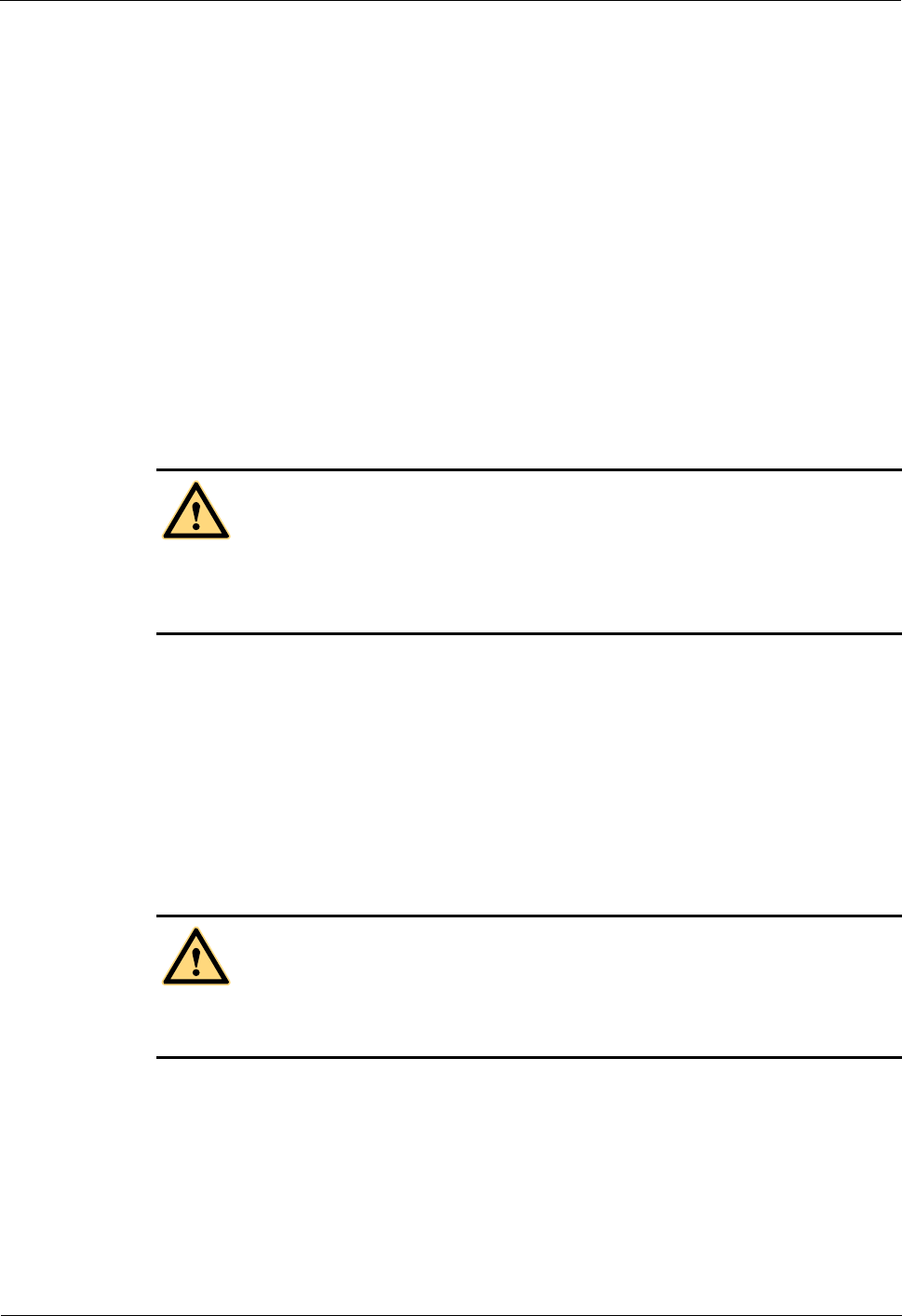
BTS3202E
Compliance and Safety Manual
4 Sicherheitsinformationen
Issue 02 (2012-04-30)
Huawei Proprietary and Confidential
Copyright © Huawei Technologies Co., Ltd
4-17
Benutzung von Leitern
Beachten Sie folgende Hinweise bei der Benutzung einer Leiter:
Stellen Sie sicher, dass Ihr Schwerpunkt nicht über die Leiterseiten hinausgelangt.
Um Gefährdungen zu verringern, nehmen Sie zuerst eine sichere Stellung auf der Leiter
ein, bevor Sie mit den Arbeiten beginnen.
Steigen Sie nicht über die viert letzte Sprosse hinaus.
Falls Sie über die Leiter auf hochgelegene Flächen steigen müssen, muss die Leiter
mindestens ein Meter über die Fläche hinausragen.
4.8 Mechanische Sicherheit
4.8.1 Bohren
WARNUNG
Das Bohren von Löchern in das Gestell ist ohne Genehmigung strengstens untersagt. Das
Bohren unter Nichtbeachtung von Sicherheitsvorkehrungen kann Leitungen und Kabel
innerhalb des Gestells beschädigen. Bohrspäne können Kurzschlüsse verursachen.
Vor dem Bohren isolierende Schutzhandschuhe anziehen, und Kabel im inneren des
Gestells entfernen.
Während des Bohrens eine Schutzbrille tragen. Späne können Ihre Augen verletzen.
Stellen Sie sicher, dass keine Metallspäne in das Gestell gelangen.
Einige Bohrmethoden können die elektromagnetische Abschirmung beschädigen.
Entfernen Sie nach dem Bohren sofort die Späne.
4.8.2 Scharfkantige Gegenstände
WARNUNG
Benutzen Sie Handschuhe beim Tragen von Gegenständen, um Verletzungen durch scharfe
oder spitze Objekte zu vermeiden.
4.8.3 Handhabung von Ventilatoren
Stellen Sie sicher, dass:
Sie beim Austauschen eines Bauteils das Bauteil selbst, Schraube und Werkzeug auf
einen sicheren Platz legen, um zu verhindern, dass diese Teile in den laufenden
Ventilator fallen.
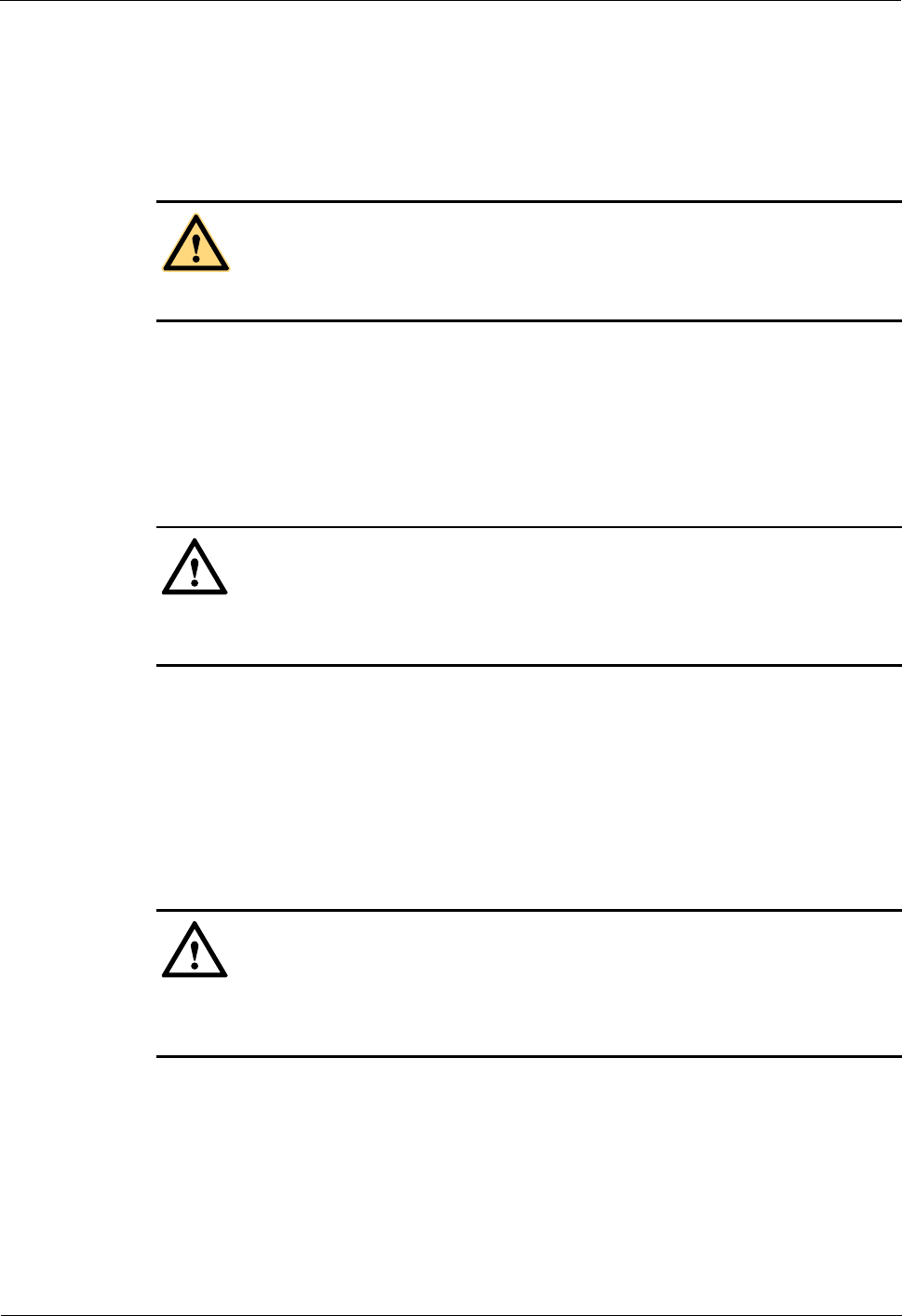
BTS3202E
Compliance and Safety Manual
4 Sicherheitsinformationen
Issue 02 (2012-04-30)
Huawei Proprietary and Confidential
Copyright © Huawei Technologies Co., Ltd
4-18
Sie beim Austauschen der den Ventilator umgebenden Betriebseinrichtung Ihre Finger
oder die Leiterplatte nicht in den laufenden Ventilator halten; nicht eher bis der Ventilator
ausgeschaltet wurde und nicht mehr läuft.
4.8.4 Anheben schwerer Gegenstände
WARNUNG
Es ist verboten, unter einem angehobenen Gegenstand zu stehen oder durchzulaufen.
4.9 Sonstiges
4.9.1 Einsetzen und Entfernen von Leiterplatten
VORSICHT
Falls Sie Leiterplatten einsetzen, seien Sie vorsichtig, um ein Verbiegen der Anschlüsse auf
der Rückseite zu vermeiden.
Setzen Sie Leiterplatten nur entlang der Führungsschlitze ein.
Verhindern Sie Kontakt von Leiterplatten untereinander, um Kurzschlüsse und Kratzer
zu vermeiden.
Berühren Sie nicht mit den Fingern die Schaltkreise, Einzelkomponenten, Verbindungen
und Verbindungsschlitze.
4.9.2 Zusammenlegen von Signalleitungen
VORSICHT
Bündeln Sie Datenleitungen nicht zusammen mit Strom- oder Spannungskabel.
Benutzen Sie Kabelbinder in einen Abstand von maximal 150 mm.
4.9.3 Verkabelungsanforderungen
Bei sehr niedrigen Temperaturen kann ein Bewegen des Kabels die Kunststoffverkleidung des
Kabels beschädigen. Um die Bausicherheit zu gewährleisten, befolgen Sie die nachfolgenden
Anordnungen:
Stellen Sie beim Installieren von Kabeln sicher, dass die Umgebungstemperatur über 0°C
beträgt.

BTS3202E
Compliance and Safety Manual
4 Sicherheitsinformationen
Issue 02 (2012-04-30)
Huawei Proprietary and Confidential
Copyright © Huawei Technologies Co., Ltd
4-19
Wenn Kabel an einem Ort aufbewahrt werden, an dem die Temperatur unter 0°C ist,
bringen Sie die Kabel vor der Installation an einen Ort mit Raumtemperatur und
bewahren Sie diese dort für mehr als 24 Stunden auf.
Bewegen Sie die Kabel vorsichtig, besonders bei niedrigen Temperaturen. Lassen Sie die
Kabel nicht direkt vom Lastenheber fallen.

BTS3202E
Compliance and Safety Manual
5 Acronyms and Abbreviations
Issue 02 (2012-04-30)
Huawei Proprietary and Confidential
Copyright © Huawei Technologies Co., Ltd
5-1
5 Acronyms and Abbreviations
A
AC
alternating current
ALS
automatic laser shut-down
ASIC
application specific integrated circuit
B
BOM
bill of material
C
CFR
cell filling rate
E
EC
electromagnetic compatibility
EMC
electromagnetic compatibility
ESD
electrostatic discharge
ETSI
European Telecommunications Standards Institute
F
FCC
Federal Communications Commission
G
GUI
graphic user interface
I
IEC
International Electrotechnical Commission

BTS3202E
Compliance and Safety Manual
5 Acronyms and Abbreviations
Issue 02 (2012-04-30)
Huawei Proprietary and Confidential
Copyright © Huawei Technologies Co., Ltd
5-2
ITE
information technology equipment
L
LIC
large-scale integrated circuit
S
SELV
safety extra-low voltage
T
TNV
telecommunication network voltage